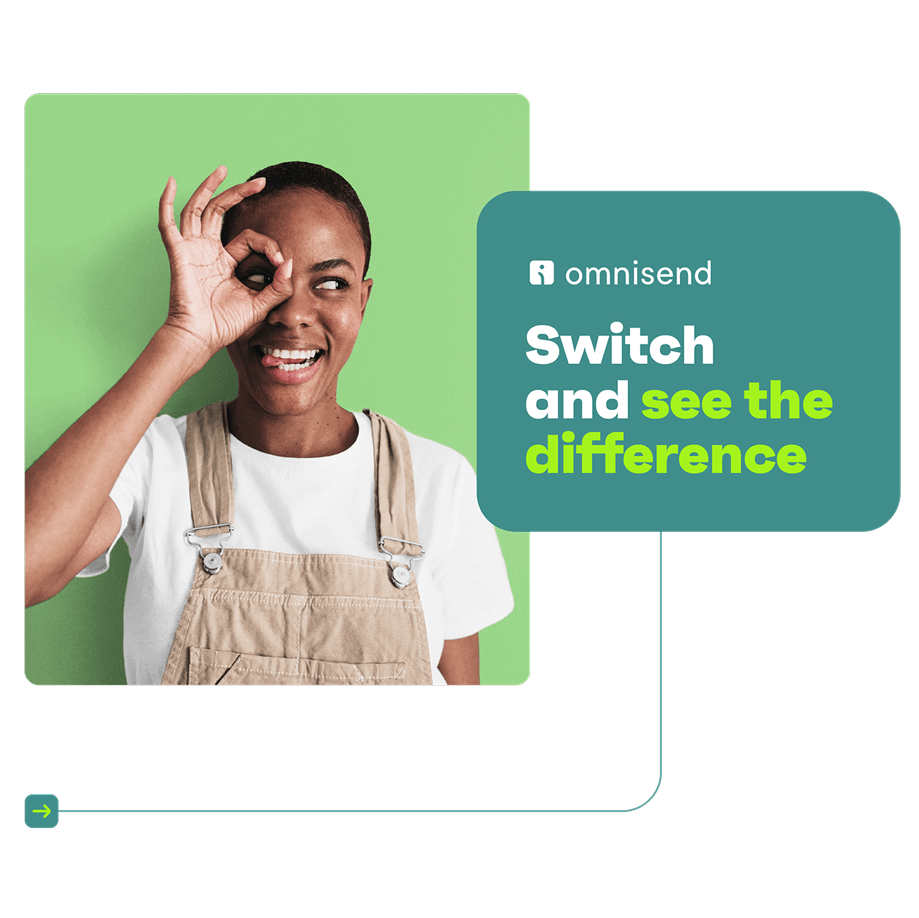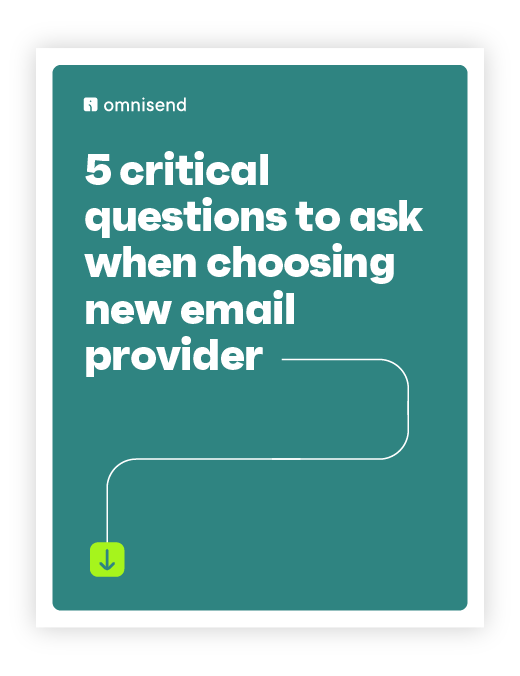
Drive sales on autopilot with ecommerce-focused features
See FeaturesYour email marketing platform will either provide the tools to grow and achieve an ROI, or it won’t. Omnisend vs. Brevo (Sendinblue) is a choice between ecommerce features that convert browsers into buyers versus business tools for marketing and sales cycles.
Omnisend is the best choice for ecommerce businesses of all sizes. It maps your customer journey with abandoned cart, browse recovery, post-purchase, and behavior-triggered flows, and lets you create multichannel email, SMS, and push notification automations.
Brevo is also suitable for ecommerce, but its focus is on small and medium-sized businesses, with CRM and sales tools to close deals and manage pipelines.
This article provides a complete Brevo vs. Omnisend comparison, including features, pricing, use cases, and performance to help you pick the right email tool for you.
Quick sign up | No credit card required
Omnisend vs. Brevo: A brief overview
Omnisend and Brevo have been around for some time. Brevo (formerly Sendinblue) was founded in 2012. Omnisend launched a little later, in 2014.
Both platforms have proven track records. Brevo serves over 500,000 customers globally, while Omnisend powers 80,000+ ecommerce brands. On G2, Omnisend scores slightly higher with 4.6/5 from 1,002 reviews. Brevo holds 4.5/5 from 2,425 reviews.
It’s fair to say then that both are reputable email marketing software solutions with practical features to help your business achieve growth.
Brevo offers CRM and sales pipeline tools alongside email marketing. Small and medium businesses choose Brevo when they need integrated business tools, not just marketing automation.
Omnisend builds every feature around ecommerce workflows, including cart recovery, product recommendations, and purchase-based segmentation. Fast-growing online stores like Hallmark Cards Australia or ModCloth, an American online clothing retailer, rely on Omnisend’s pre-built automations to target customers at optimal moments.
Omnisend vs. Brevo: A side-by-side comparison
The table below compares Brevo and Omnisend’s features:
| Omnisend | Brevo | |
|---|---|---|
| Email campaigns | • Intuitive drag-and-drop editor • Customizable email templates • A/B testing, either one element at a time or all at once • Reusable ecommerce-focused blocks with recommended products or discount codes • Campaign booster • Unique discount codes for Shopify users | • Drag-and-drop editor • Customizable email templates • A/B testing, one element at a time |
| Marketing automation | • Supports automated workflows for email, SMS, and web push notifications • A/B tests for workflow optimization • Pre-built customizable workflows • Revenue and engagement data of workflows | • Supports automated workflows for email, SMS, WhatsApp, and chat • A/B tests for workflow optimization • Built-in CRM for sales pipeline management |
| Transactional email | • Pre-built flows for order, shipping, and order cancellations • High-quality, brandable email designs to replace basic ones | • Handles order and shipping confirmations for ecommerce • Fewer transactional email designs |
| Email list-building | • GDPR-compliant list-building tools • Landing pages • Signup forms • Facebook ads • 250+ customizable email templates • Smart targeting • Wheel of Fortune • Teasers • Multi-step popups • Performance reports | • GDPR and CCPA-compliant list-building tools • Landing pages • Signup forms • Facebook ads • 50+ free email templates |
| Segmentation | • Segmentation based on website behavior, past purchases, declared interests, and more • Real-time automatic updates of segments • Customer lifecycle-based segmentation • Segmentation suggestions | • Segmentation based on website behavior, past purchases, and declared interests • Very few segment suggestions |
| Analytics and reporting | • Spot-on revenue attribution • KPIs available in single or channel-level view • Click map reports • No extra setup for conversion reports | • Real-time reporting • Granular reporting • Click map reports • Conversion part requires extra setup |
| AI features | • Segment builder • Subject line generator • Email content generator • Brand assets • Campaign booster (automatic resends to unengaged subscribers) | • Aura chatbot for segments, content generation • Sales assistant • Conversations agent |
| Pricing | • Pricing based on the number of contacts • Paid plans start from $16/month | • Pricing based on the email sends • Paid plans start from $9/month |
| Free plan | • Includes all standard features • Send up to 500 emails/month to 250 contacts • No advanced reporting • No personalized product recommender | • Limits standard features, including contact scoring, dynamic coupons, A/B testing, and push notifications • Send up to 300 emails/day |
| Customer support | • Email support • 24/7 live chat support even on the free plan • Account expert for Standard and Pro plan customers with plans exceeding $400/month | • Email support • Phone and chat support for Business and Enterprise plans • Dedicated account manager for Enterprise customers • API documentation and community support |
| SMS campaigns | • Bulk SMS campaigns • Personalized transactional SMS • Ability to run SMS campaigns along with email and push notifications • Supports all country codes | • Bulk SMS campaigns • Personalized transactional SMS • Ability to run SMS campaigns along with email and push notifications • Supports all country codes except for Singapore |
| Integration | Supports 160+ integrations | Supports 150+ integrations |
Email campaigns
When it comes to email marketing, both Omnisend and Brevo are mass email service providers equipped with powerful features.
One capability you’ll find in both tools is a drag-and-drop editor that lets you create campaigns and edit email newsletters intuitively.
The screenshot below shows Omnisend’s email template library:
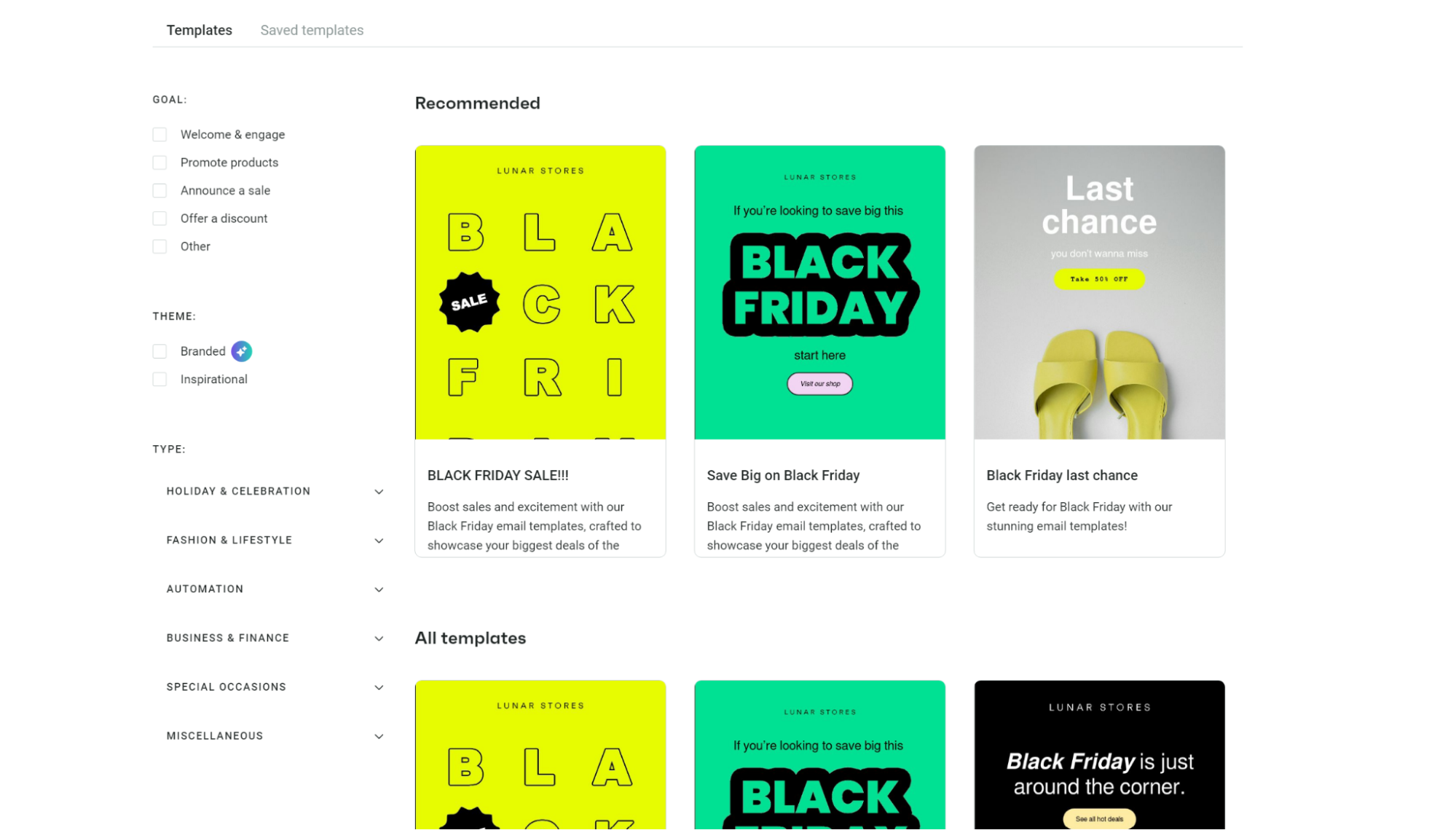
You can browse email templates by goal, such as welcome and engage, by theme, such as inspirational, and by type, such as fashion & lifestyle. In total, there are 250+ customizable email templates that you can edit.
Plus, as well as saving your templates and sharing them across other stores you may have, you can save individual blocks to reuse in future campaigns. All this is a time-saver.
Brevo’s template library is less impressive than Omnisend’s. It only lets you search by template type (anniversary, announcement, confirmation, etc.), and there are fewer unique templates, with many of the designs being similar.
The image below shows Brevo’s template library:
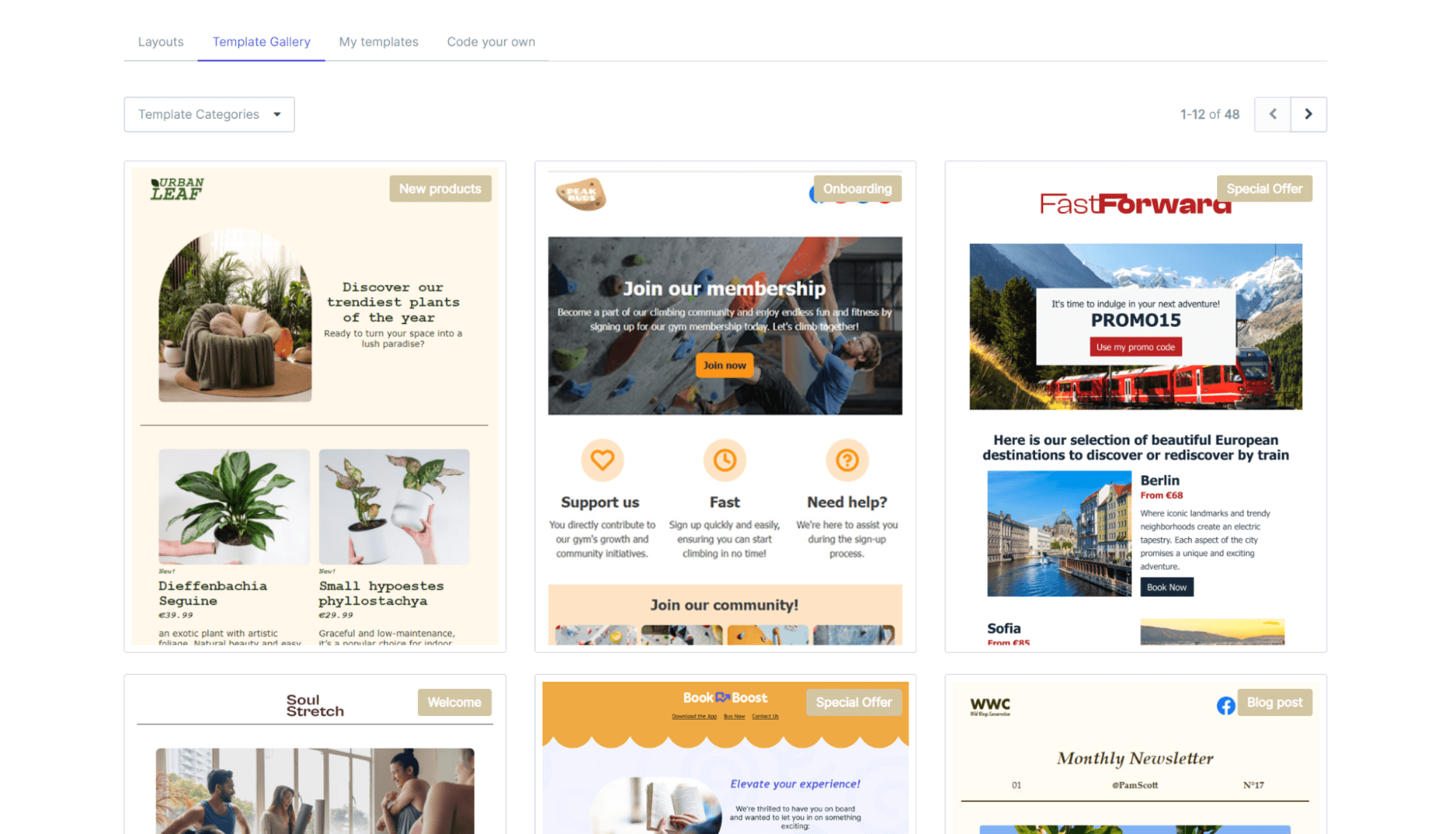
G2 reviewers consistently rate Omnisend’s templates higher than Brevo’s. While Omnisend reviewers say its templates “already look professional,” Brevo reviewers say that its templates lack variety and are “limited compared to other tools.”
Overall, Omnisend is the clear winner for ecommerce email templates thanks to its more numerous options and sleeker designs.
Another area where Omnisend is superior to Brevo is the ecommerce elements you can add to emails. For instance, it lets you add a product listing or product recommender item with or without personalization. Here’s an image of the products you can recommend:
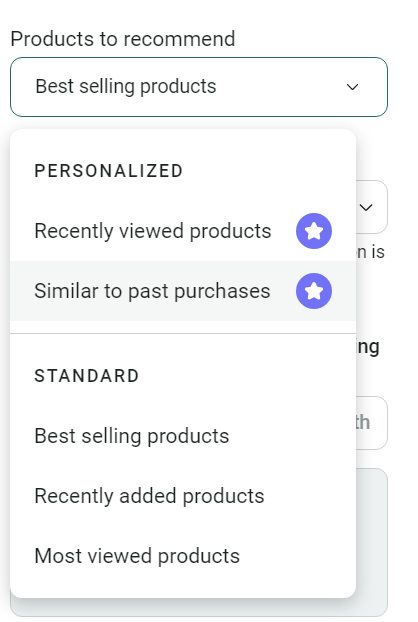
Do you see the option above for recently viewed products? That’s a new feature added in August 2025. It was previously limited to automations, but it had such excellent engagement metrics that we had to add it to campaigns, too.
Brevo doesn’t offer a comparable product recommender element for campaigns. So, if you want to recommend products in emails, Omnisend is the way to go.
When it comes to creating content for your emails, Omnisend and Brevo have AI features to assist. Aura (Brevo’s AI chatbot) lives within the template editor, letting you prompt it to generate a paragraph, title, or button.
Omnisend’s AI appears in subject line and preheader fields with one-click generation based on campaign context. Within email content, it offers grammar fixes, rephrasing, and tone adjustments:
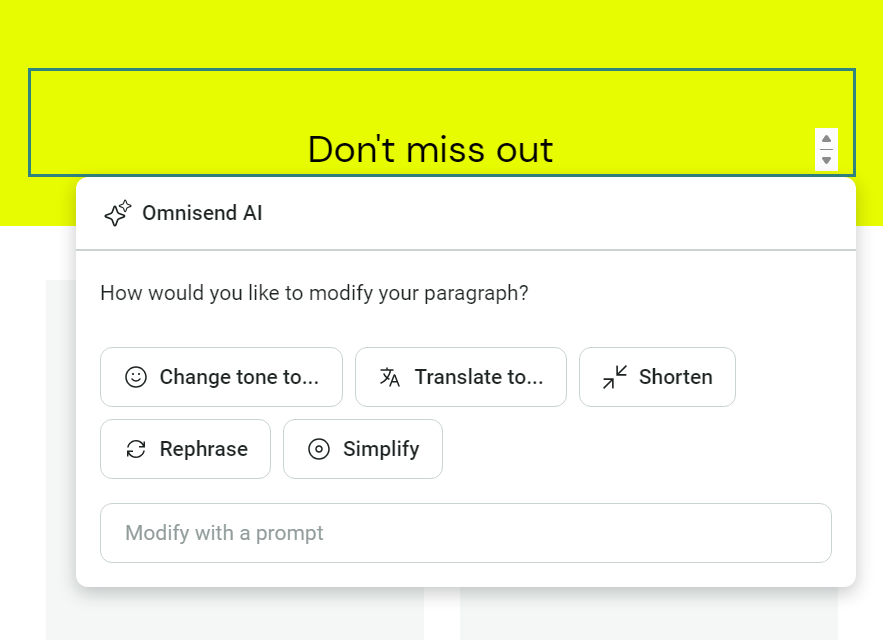
Additionally, you can request custom prompts, such as “make this more celebratory,” or “shorten to 50 characters.” The AI saves conversation history during campaign creation.
Omnisend offers a campaign booster across all plans, which guarantees that your emails will get more opens by automatically resending emails that go unopened. You can use it to improve engagement and conversions in campaigns:
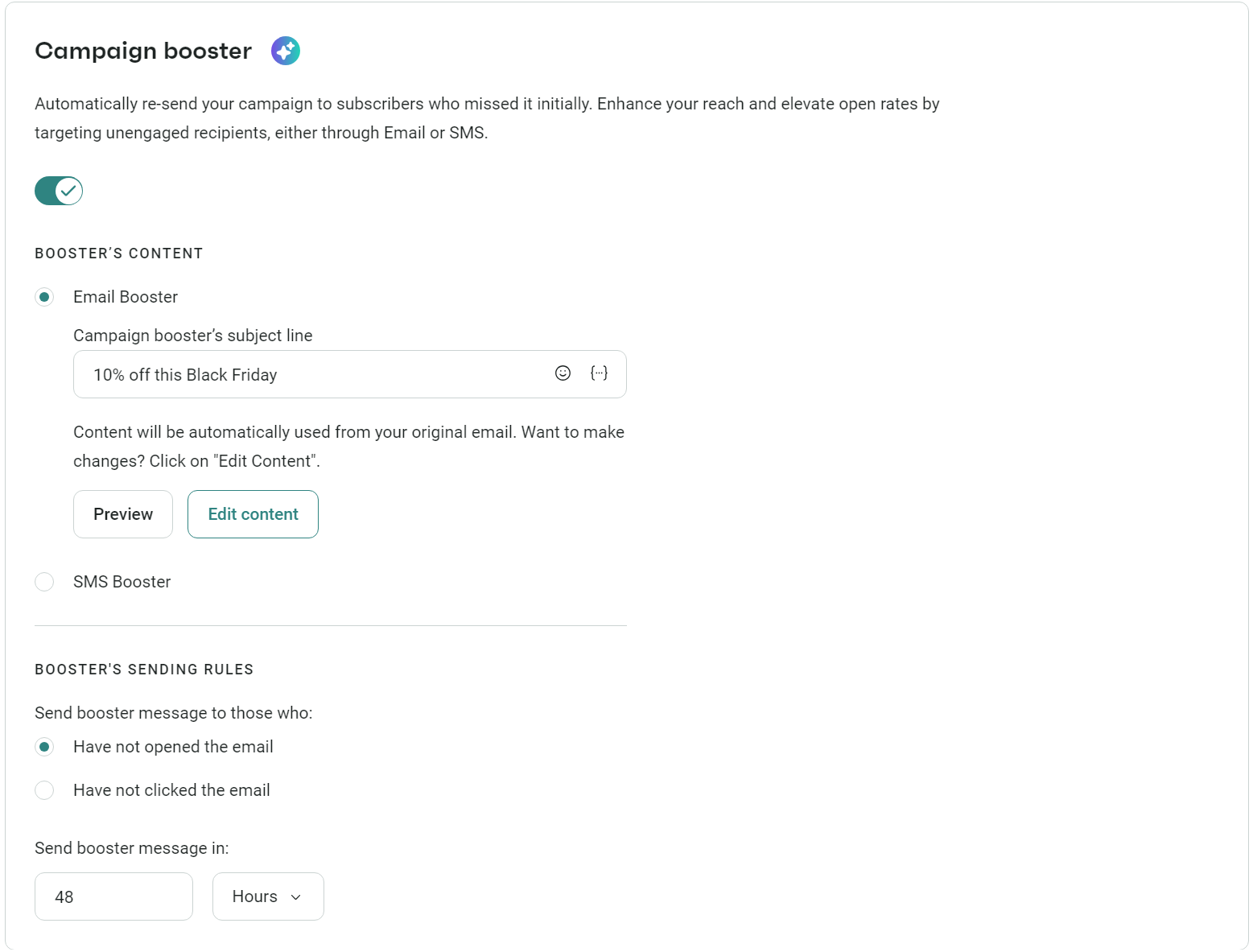
Both tools also offer campaign A/B testing to find winning email versions. However, only Omnisend includes A/B testing across all plans. Brevo restricts A/B testing to its Standard plan, which starts at $18/month.
Brevo’s A/B tests focus on subject line and content variations only, while Omnisend adds sender name/email testing options for additional insights.
If you’re also looking for a quick comparison of the best SMS marketing platforms like Brevo SMS, here’s a video that can help:
Let’s get into the nitty-gritty details of these marketing automation tools.
Marketing automation
Omnisend and Brevo both handle email automations to cover your customer journey from welcome series to post-purchase. Additionally, they let you add an SMS to your flows to reach customers who are subscribed to text messages.
A Brevo limitation is that web push notification support isn’t available below the Starter plan. So, if you use the free plan, you can’t add push messages to automations.
In contrast, Omnisend provides web push notification capabilities across all plans, and it lets you add push messages into email + SMS flows to reach customers at optimal moments in an omnichannel approach.
The image below shows Brevo’s automation page:
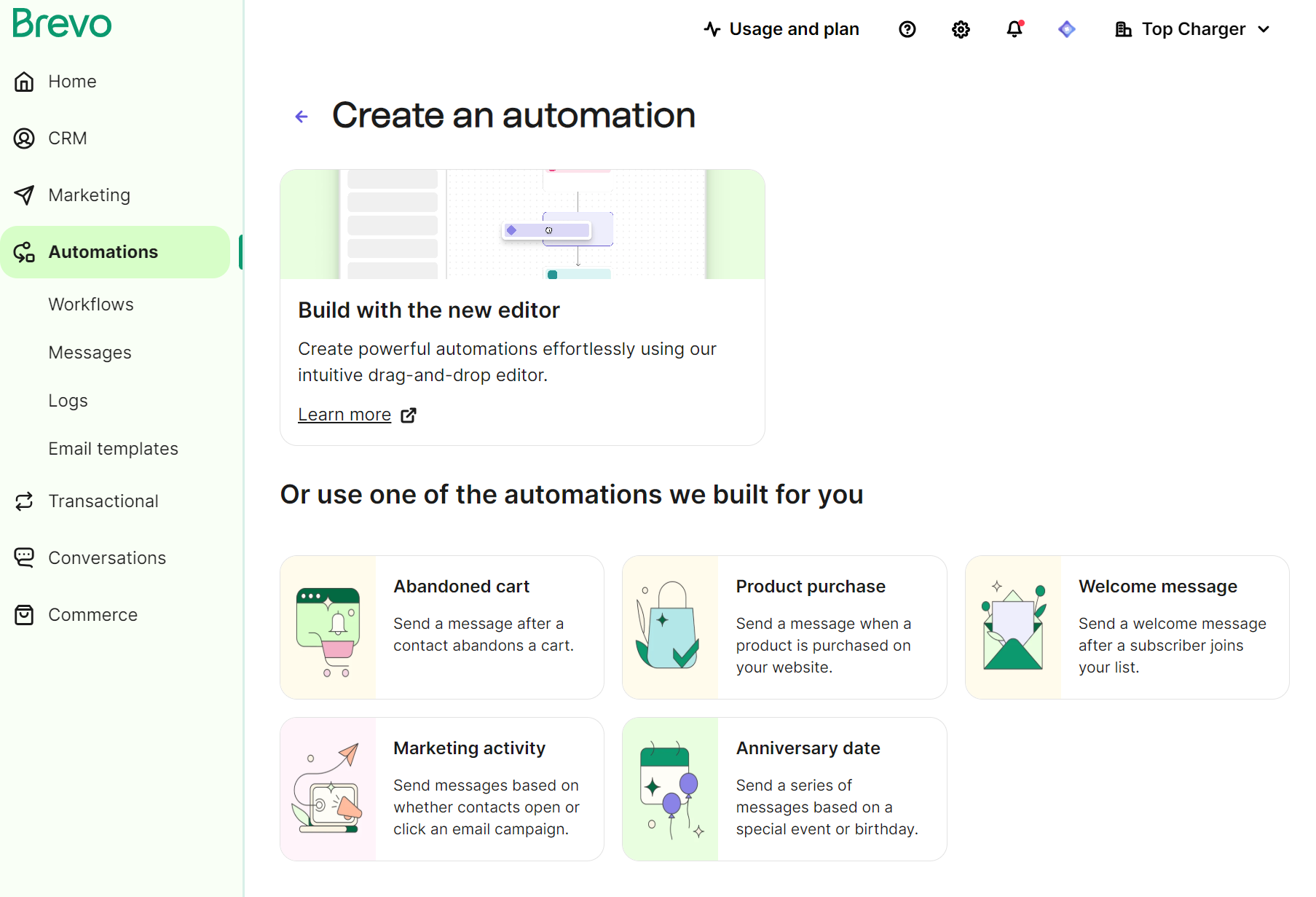
The number of pre-built automations is low (five), but Brevo’s new automation editor (released in 2025) is exceptionally easy to use. It walks you through the different steps and prompts you to add new information for a working configuration:
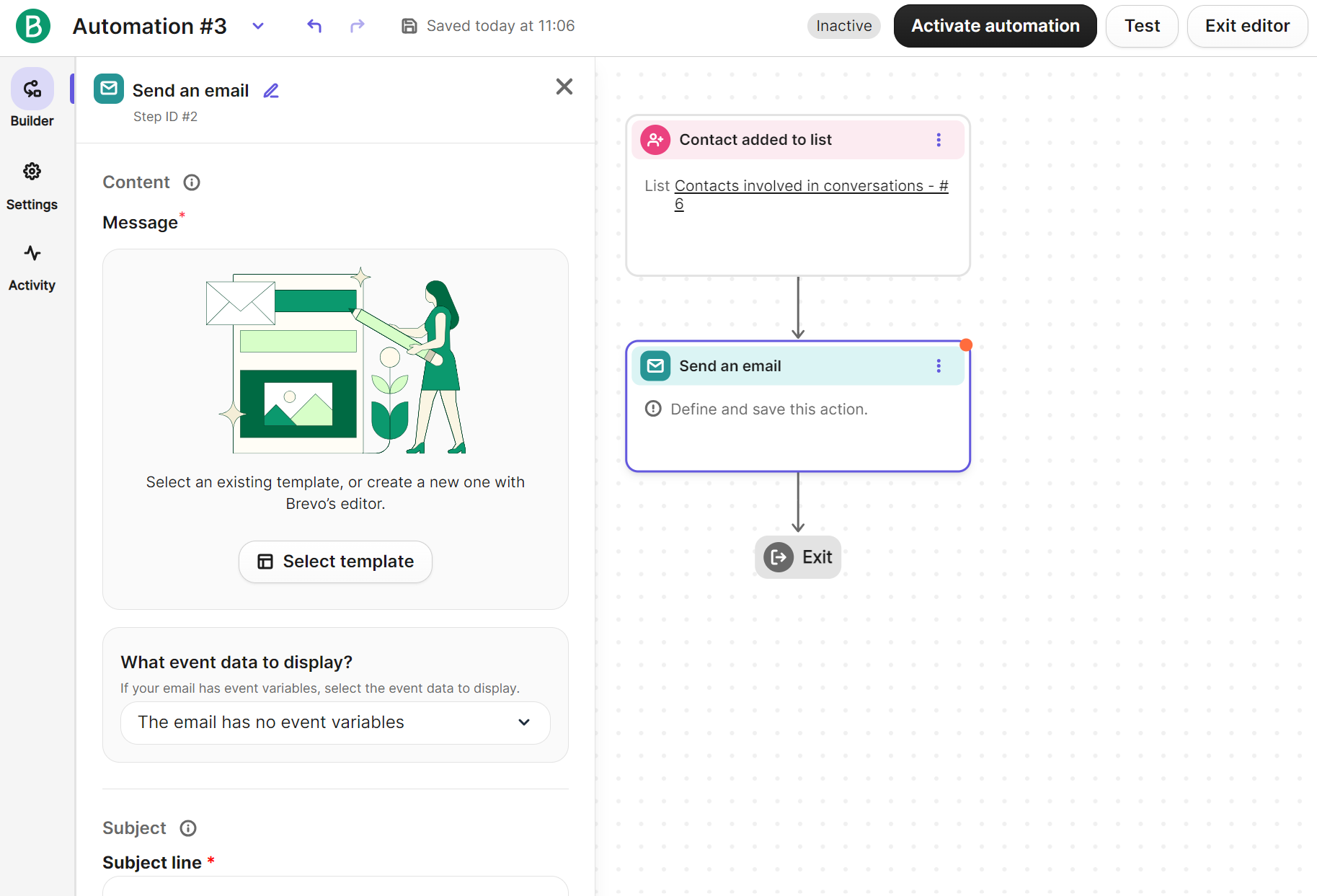
All Brevo and Omnisend plans have real-time event triggers (such as making a purchase) and multiple entry points for automations.
Where Omnisend does have a clear advantage over Brevo is in its 30+ pre-built automation templates, including:
- Welcome series
- Cart and checkout abandonment (standard, value-based splits, engagement splits)
- Browse and product abandonment workflows
- Post-purchase sequences (order confirmation, shipping updates, review requests)
- Cross-sell automations with A/B delay testing
- Customer reactivation and win-back campaigns
- Birthday and special occasion emails
- Back-in-stock notifications
- Replenishment reminders for consumable products
These pre-built templates will help you launch automations faster at scale. Here’s a screenshot showing Omnisend’s automation library:
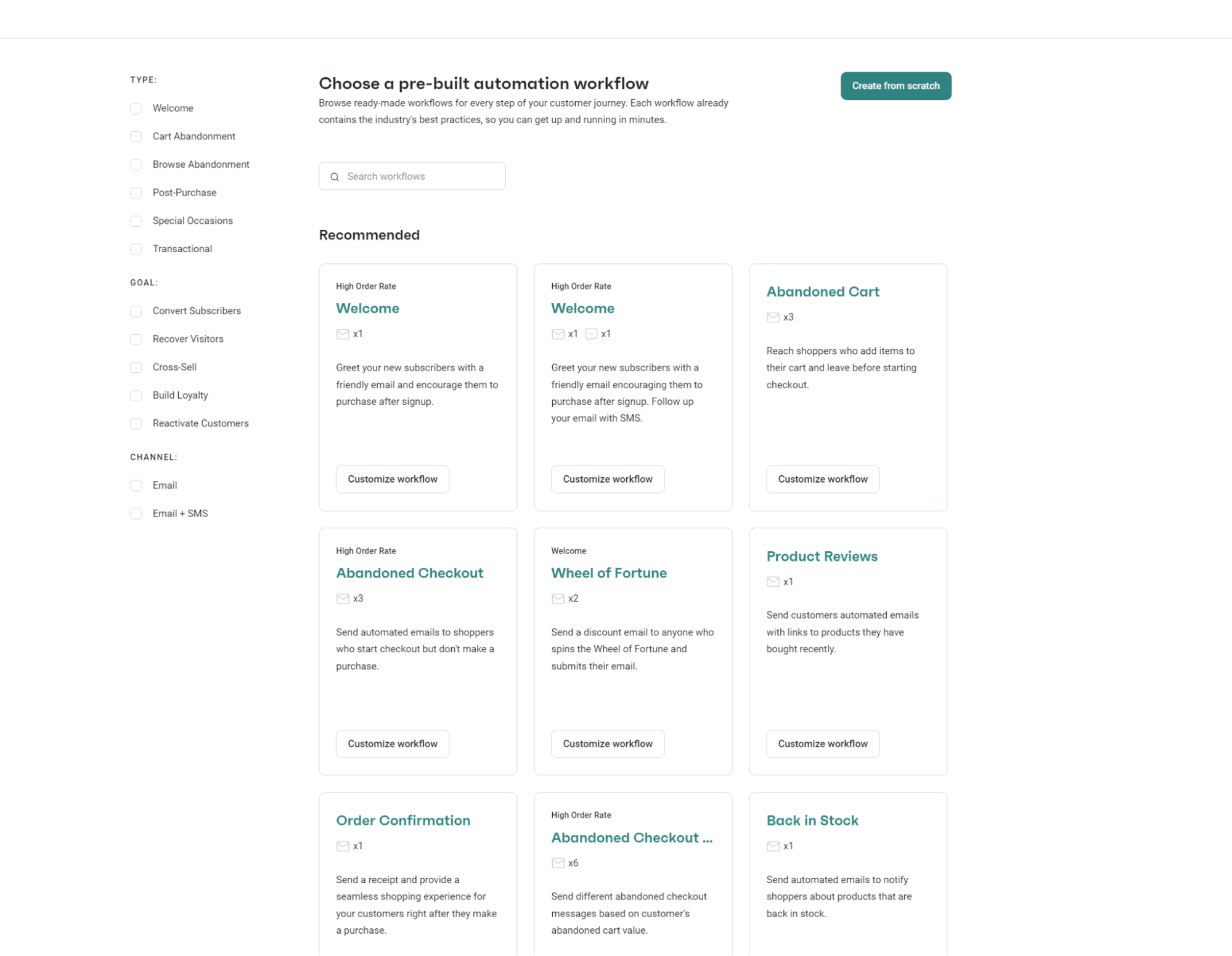
The workflow editor uses visual drag-and-drop blocks for messages, delays, splits, tags, and additional touchpoints, so building a flow takes very little time.
Setting up conditional splits based on customer behavior or purchase history improves targeting and requires just a few clicks in Omnisend and Brevo. However, Omnisend’s automation builder is more intuitive than Brevo’s. See the image below:
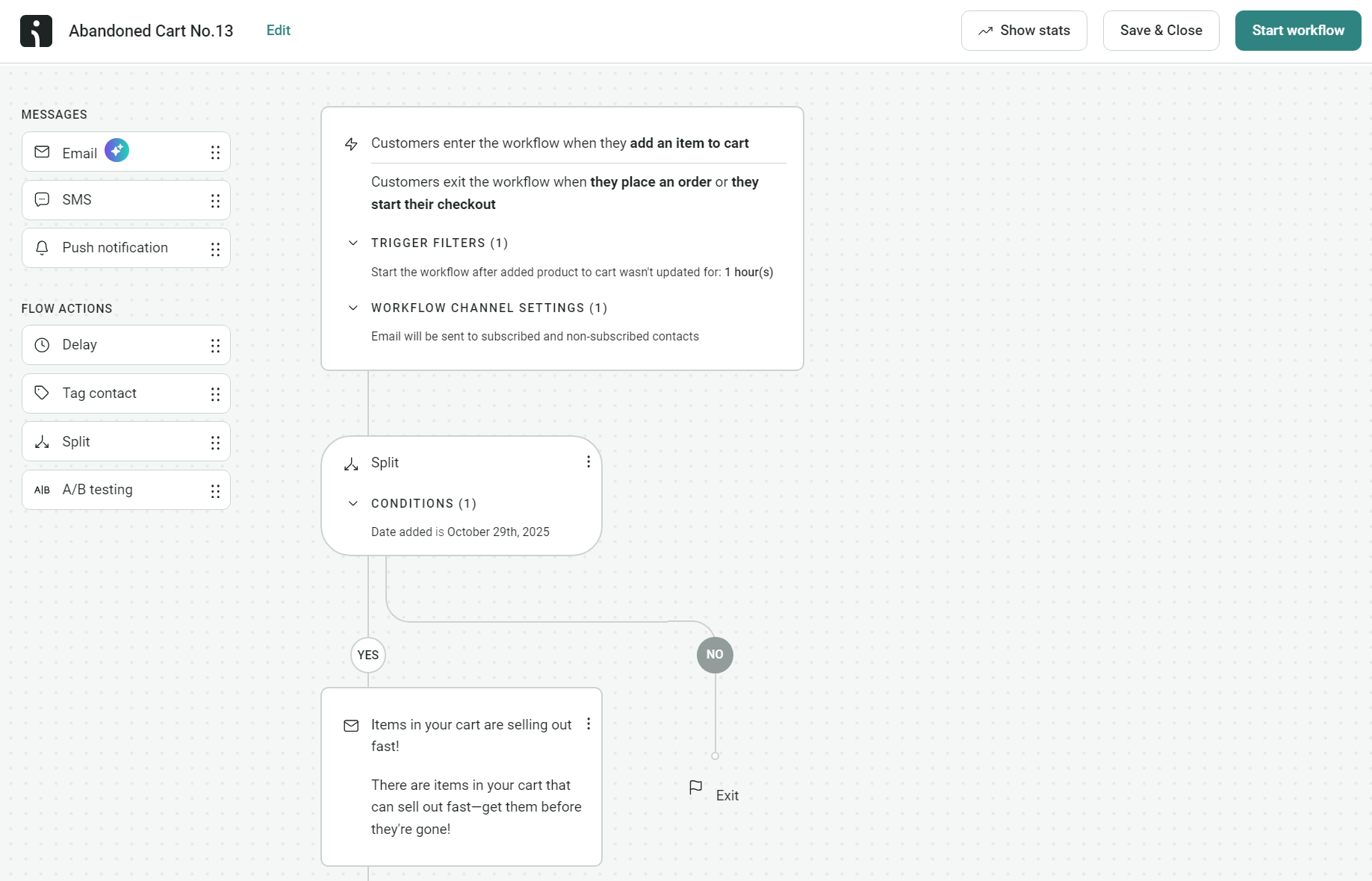
Do you see the A/B testing flow action in the image above? Dragging it into the builder lets you test two email or SMS versions to improve your results. Brevo also has A/B testing, but only in its Standard plan or above.
After starting your workflow, Omnisend’s sales attribution tracks revenue from automations with customizable windows (default seven days for email and 24 hours for SMS).
Reports show total automation-driven revenue and use last-touch attribution when customers engage with multiple messages before purchasing.
Brevo’s reporting features below the Standard plan are basic, tracking opens, clicks, unsubscribes, and device insights. Its Revenue dashboard provides attribution tracking:
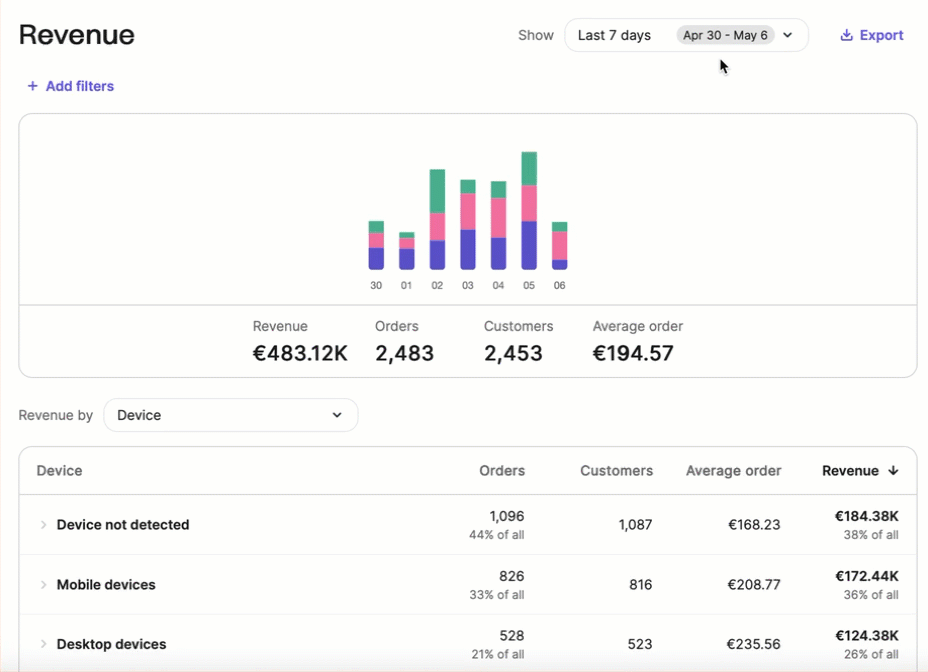
Ultimately, if you have an ecommerce store and want to set up automations that cover every conceivable customer action, Omnisend is better than Brevo. Its marketing automation includes more templates and lets you use push notifications across all plans.
An exception applies if your business manages deals and sales and requires a CRM, pipeline management, and sales automation features.
If you need these, you need an additional sales package, such as Sales Essentials (from $31/month) or Sales Advance (from $65/month). Here’s a rundown of what each plan includes:
Sales Essentials
- Unlimited open deals
- Stage rules
- Sales workflows
- Multi-user access
- Instagram and FB Messenger
Sales Advance
- Multiple currencies
- Outreach sequences
- Round-robin scheduling
Remember — pipeline and sales features are irrelevant to most ecommerce scenarios and don’t fall into the same category as marketing automations.
Email list-building capabilities
Capturing your customers’ email addresses gives you access to their inboxes, where you can nurture a strong relationship with them. But to do so, you need list-building tools that are non-intrusive and GDPR-compliant.
So which one is right for the job, Omnisend or Brevo?
Both tools offer GDPR-compliant email list-building features like landing pages and popups, but only Omnisend provides these across all plans. Brevo restricts landing pages to Standard plan users and popups to Professional users and above.
Omnisend is the only way to go if you want all these as standard:
- Popup: Center-screen overlay triggered by time, scroll, or exit intent
- Flyout: Slides in from screen edge, stays visible while browsing continues
- Teaser: Minimal edge widget that expands to complete form when clicked
- Wheel of Fortune: Gamified spinner offering discounts for email signups
- Embedded: Static forms built into page layouts like footers or sidebars
- Landing page: Standalone signup pages hosted by Omnisend for campaigns
- Multi-step: Progressive forms reveal fields gradually to reduce friction
If you do purchase one of Brevo’s plans, its landing pages are easy to create using a drag-and-drop editor, and it provides multiple templates to start fast:
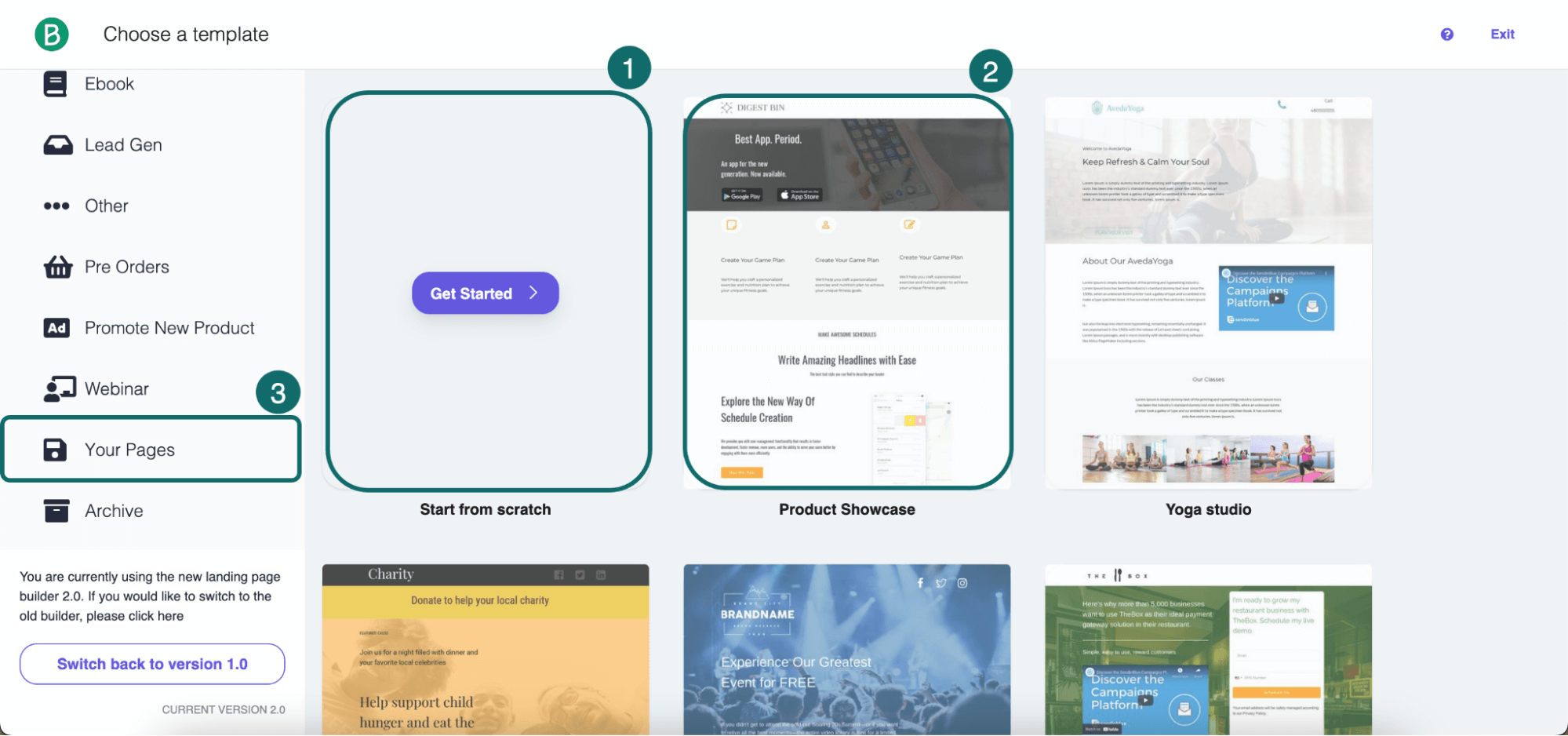
Additionally, you can add follow-up pages, get as detailed as is necessary with your questions, and add targeted CTAs that encourage conversions.
Brevo also makes it easy to provide your visitors with custom signup forms across all plans. With a drag-and-drop builder, you can add:
- Text input fields
- Images
- Radio button lists
- Dropdown lists
With Omnisend, you get a few more options for customizing and setting up popups and other signup forms. For starters, all plans include popups, embedded and flyout forms, and landing pages to build your list in multiple ways.
The image below shows Omnisend’s form library and a handful of its landing page templates:
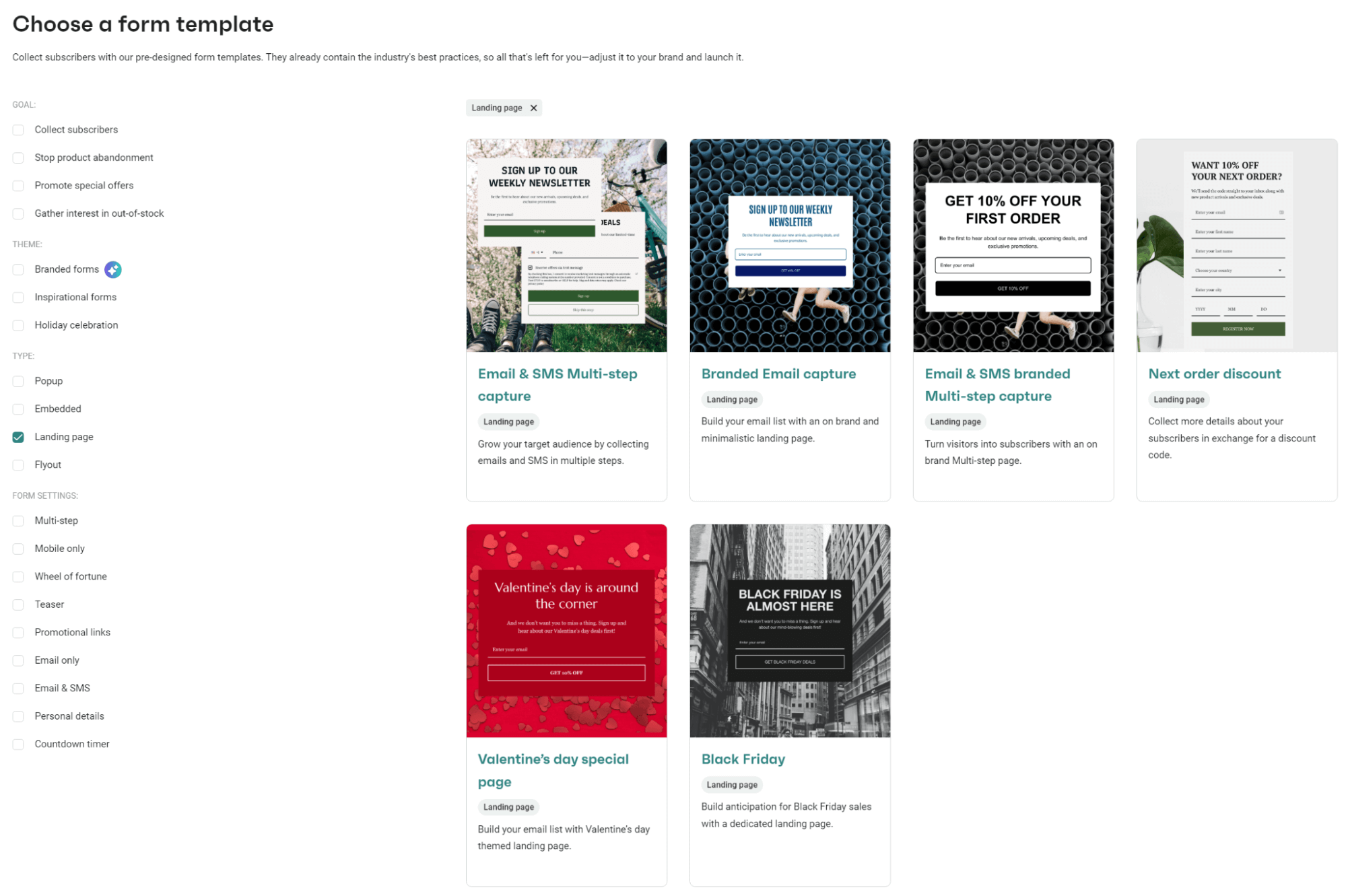
Omnisend’s popup targeting controls visibility based on visitor behavior and status. Display forms to new visitors only, existing contacts, or segment by browsing patterns and cart activity:
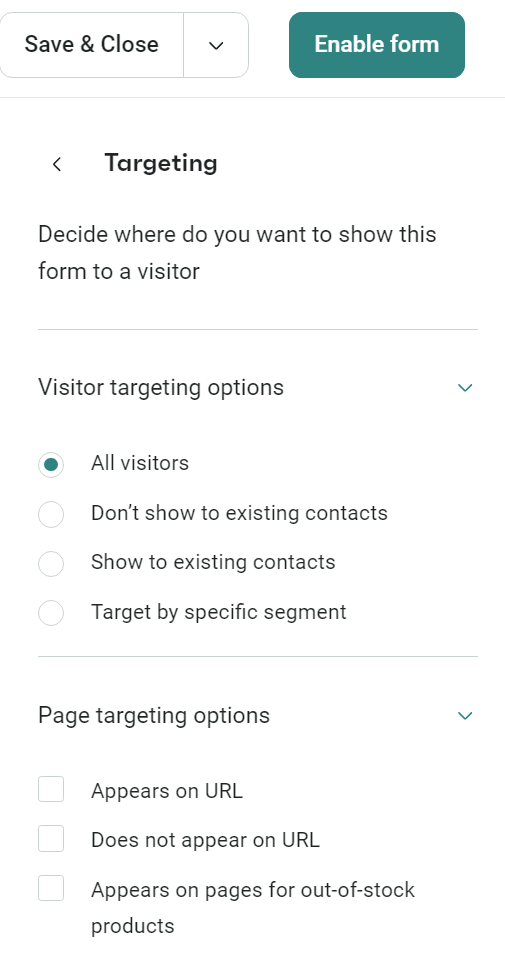
Beyond basic popups, Omnisend offers Wheel of Fortune gamification, multi-step forms that reveal progressively, and unobtrusive teasers. Teasers remain minimal on-screen until clicked, letting visitors browse freely while keeping offers accessible.
Landing pages work with your ad campaigns. Create separate pages for each campaign so messaging stays consistent from ad to signup form. Combined with popup targeting rules, you capture leads from interested visitors without blocking their shopping experience.
Overall, Omnisend is superior to Brevo for aggressively growing your email list with popups, forms, and landing pages.
Segmentation features
Omnisend and Brevo both offer behavioral segmentation, purchase history filtering, and demographic grouping. The difference lies in execution and depth, with Omnisend providing more pre-built segments for ecommerce:
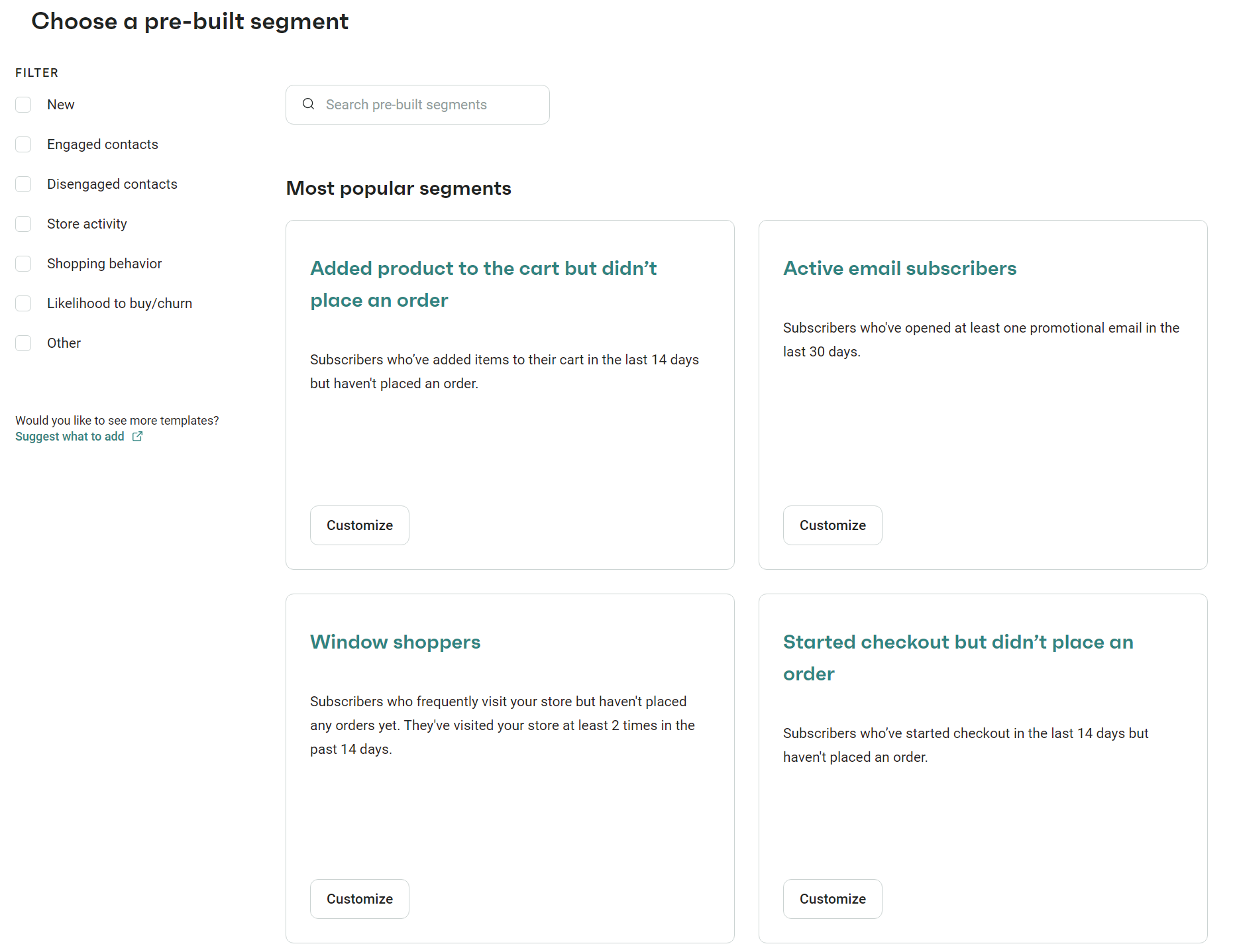
Omnisend provides eight segmentation categories with unlimited filter combinations, letting you create complex behavioral segments like “customers who viewed products but didn’t purchase in 30 days” or “repeat buyers who opened emails but haven’t clicked recently.”
The categories are as follows:
- Anniversaries
- Contact properties
- Contact location properties
- Engagement
- Orders
- Products
- Custom events
- Custom properties
These segments update automatically and work across email, SMS, and push notifications. Additionally, segments include Facebook and Google sync capabilities for retargeting your customers on social media.
Omnisend’s AI segment builder is available across all plans — type what you want (“high-value customers from last quarter”) and it builds the rules. Brevo requires manual rule creation for most users, with AI assistance limited to higher tiers.
One G2 reviewer reports, “The integration with our website and CRM is seamless, and I love how easy it is to segment audiences and personalise campaigns.”
The image below shows Omnisend’s AI segment builder in action:
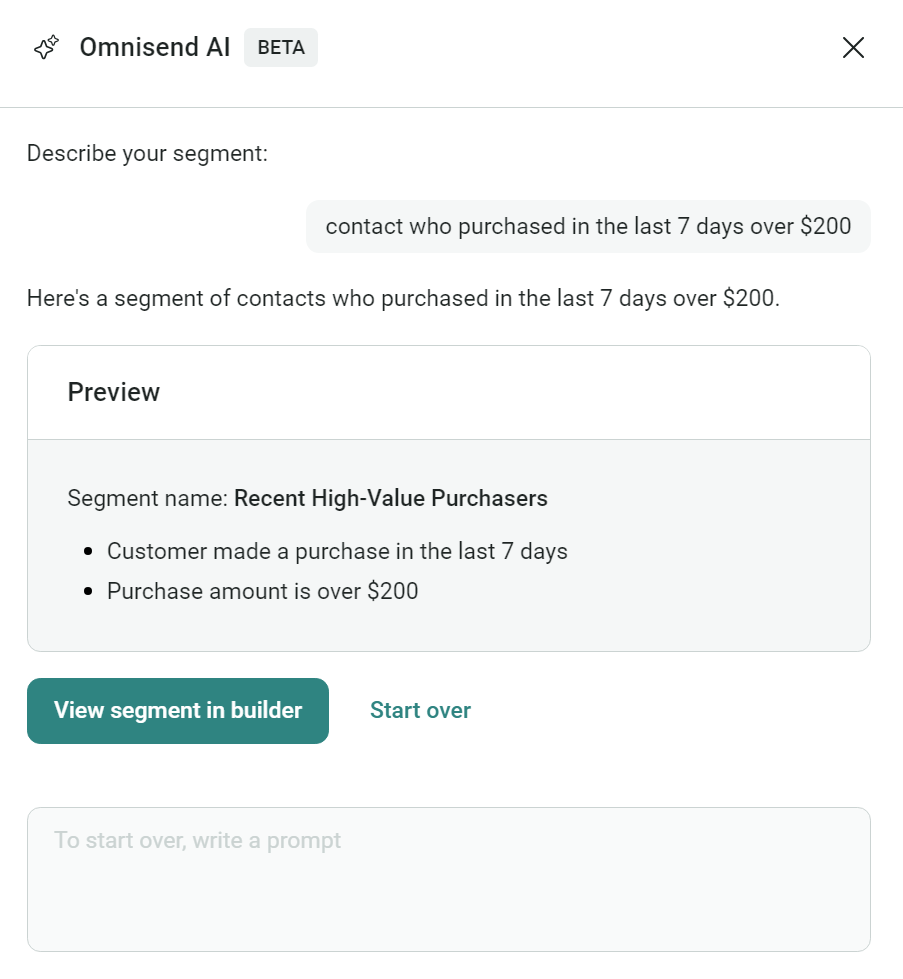
Brevo handles standard segmentation well, but caps complexity at 100 conditions. While Professional plan users get basic AI-generated segments, complete AI segmentation requires Enterprise pricing.
You can segment across email and SMS channels, though it focuses more on straightforward contact filtering than complex behavioral patterns.
The screenshot below shows Brevo’s pre-built segment templates. You’ll see that the number of templates is significantly fewer than you get with Omnisend:
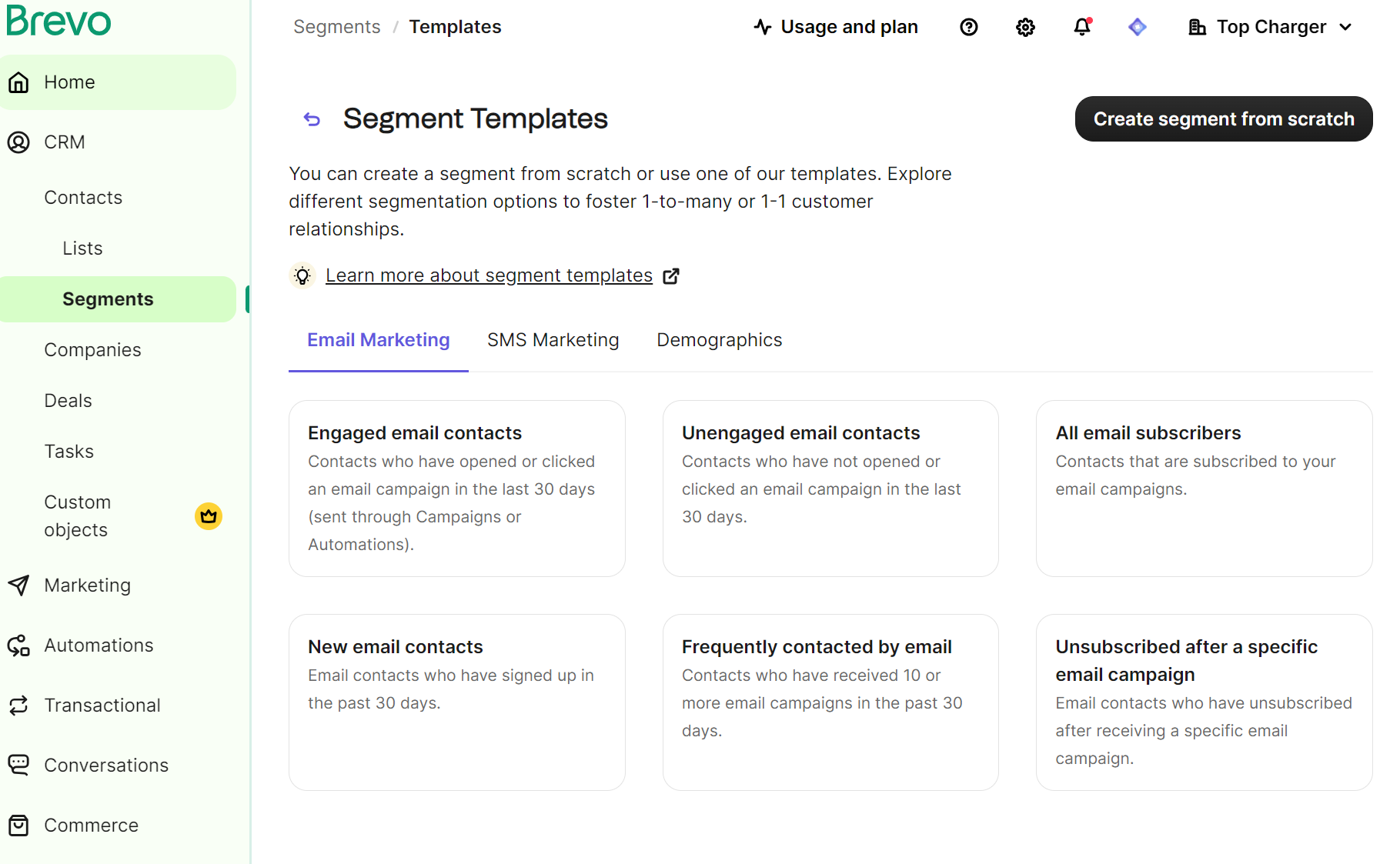
Brevo users on G2 have overwhelmingly positive thoughts on its segmentation features, with one reviewer saying, “We particularly appreciate the platform’s ability to handle a large database of contacts and segment them effectively based on the products they’ve purchased.”
Overall, Omnisend’s segment portability across marketing channels saves hours of list management. Brevo suits businesses needing straightforward contact filtering without complex behavioral tracking for ecommerce journeys.
Analytics and reporting
Omnisend’s reporting arrives ready for ecommerce without configuration. Revenue attribution, conversion tracking, and purchase data flow automatically from your store integration.
The dashboard displays total store revenue versus Omnisend-attributed sales, letting you see marketing ROI instantly. Individual workflow performance breaks down revenue by automation type — abandoned cart recovery versus welcome series — helping you invest in what works.
The image below shows Omnisend’s sales and marketing activity reports:
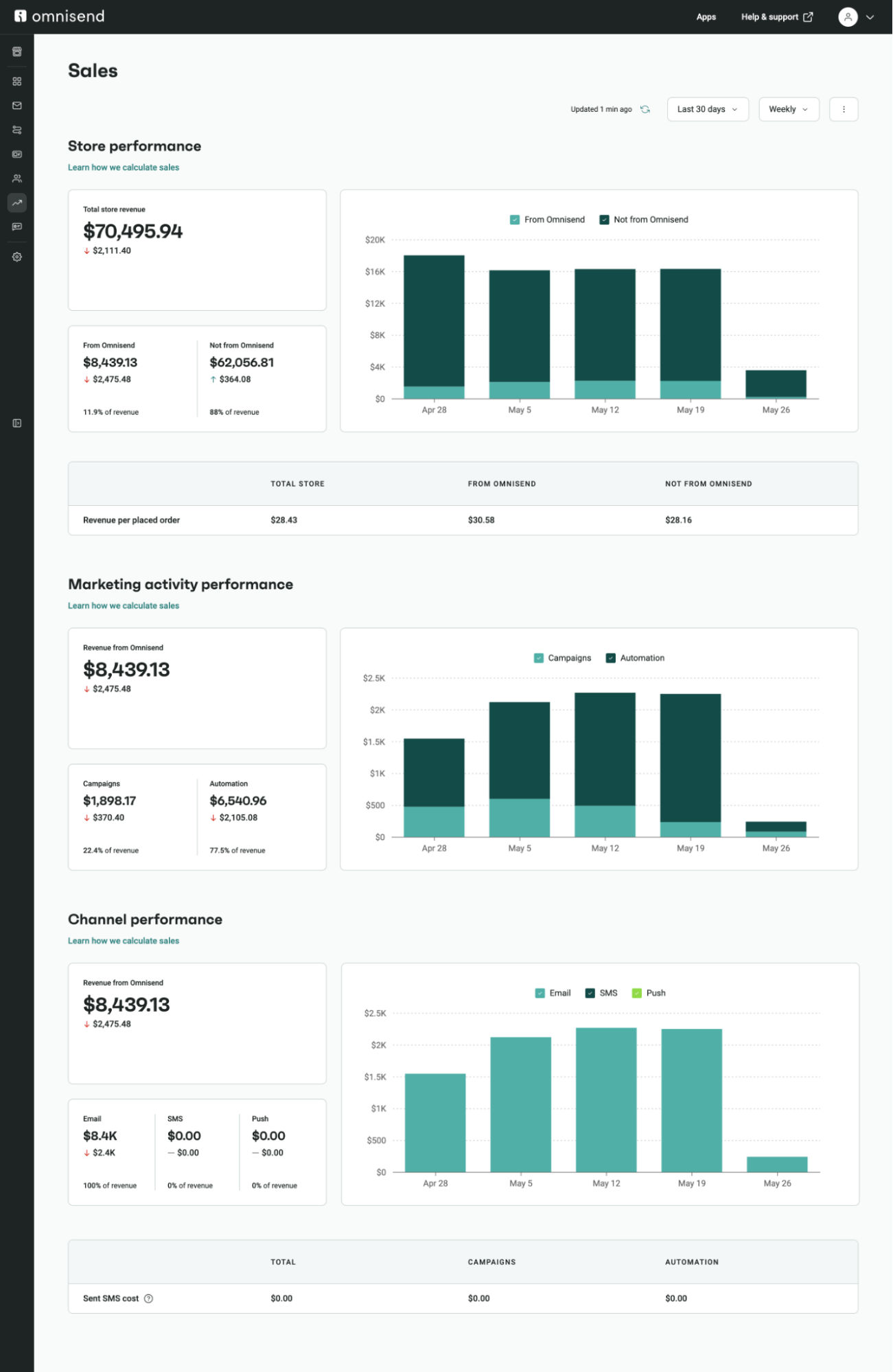
With Brevo’s reports, you can track email campaign performance across deliverability, opens, clicks, conversions, revenue, and unsubscribes.
Each metric has dedicated tabs showing geographic distribution, device breakdowns, hourly engagement patterns, domain-level analysis, and A/B test comparisons:
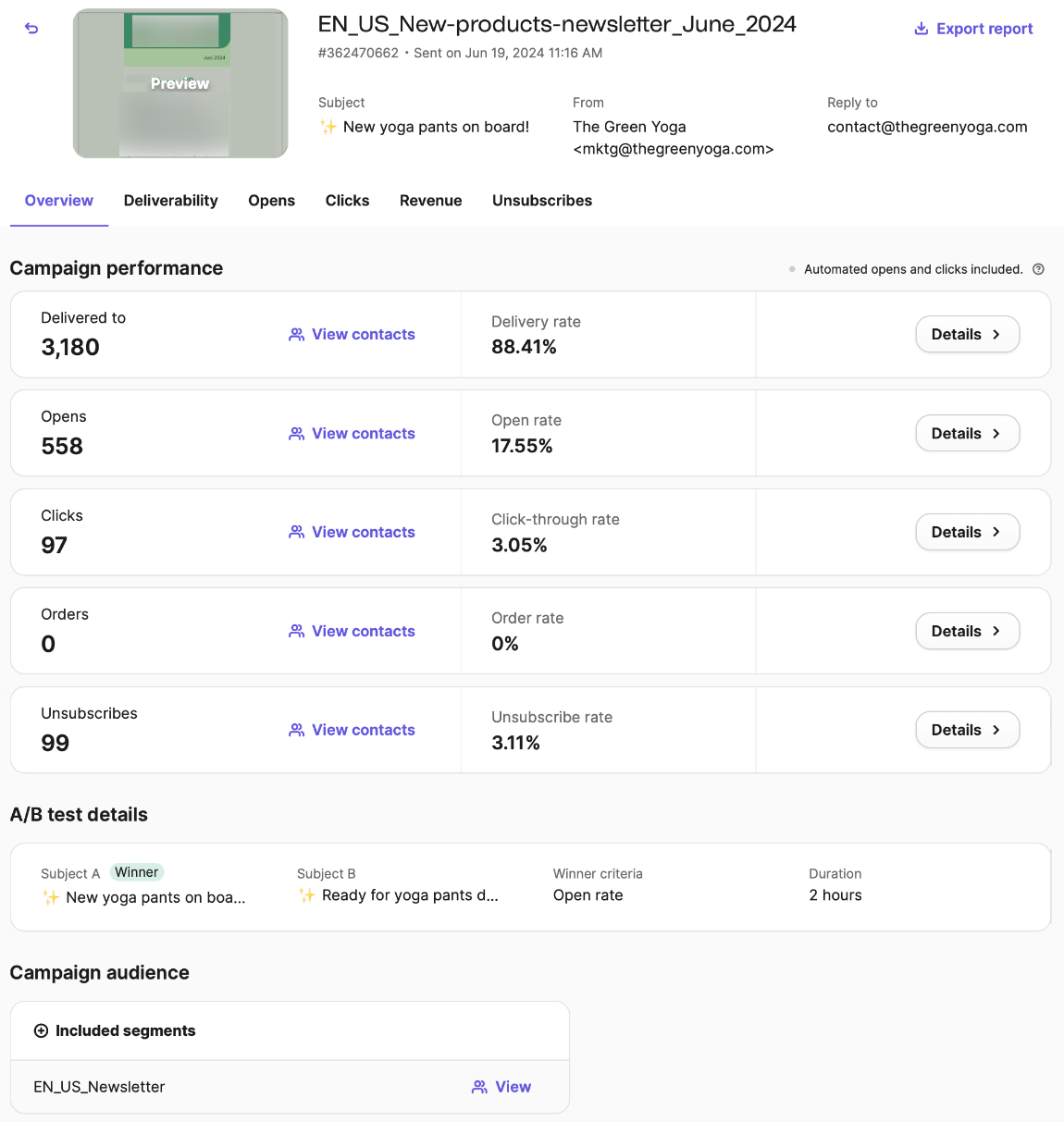
However, Brevo requires a manual conversion setup to track sales, adding complexity for ecommerce stores. It offers real-time deliverability alerts and filtering options that benefit B2B senders monitoring domain reputation.
Email client breakdown (Gmail versus Outlook performance) and geographic distribution maps in Brevo provide detailed recipient analysis.
Click heatmaps appear in both platforms for visualizing engagement patterns. The GIF below shows how to navigate the Click Map in Omnisend:
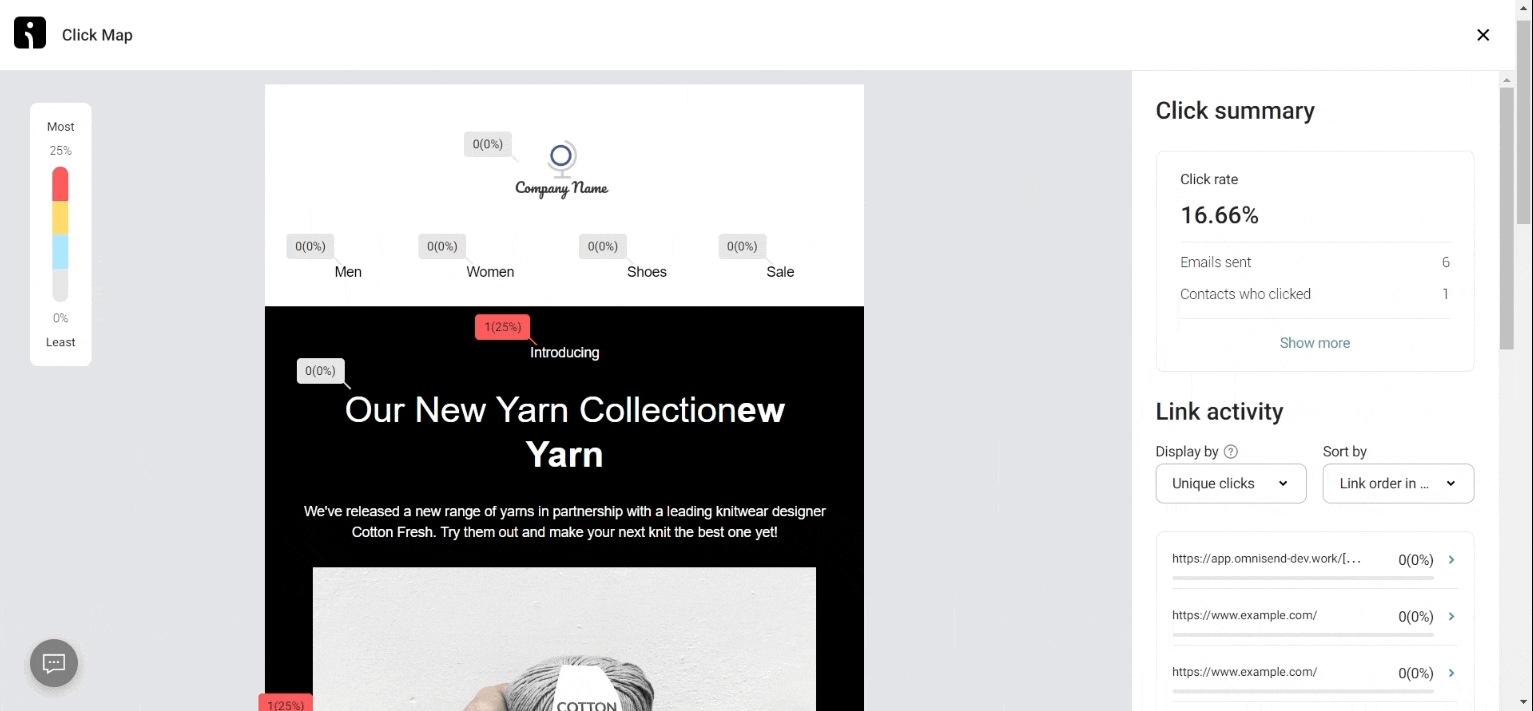
Omnisend’s unified dashboard consolidates email, SMS, and push metrics in one view. For ecommerce operations prioritizing revenue insights and a multichannel overview, Omnisend’s automated tracking saves setup time while capturing purchase data.
If you need advanced deliverability monitoring and detailed recipient behavior analysis, Brevo’s granular reporting fits better.
SMS capabilities
Omnisend gives $1 SMS credit on Free plans, letting you test before committing. Pro plans include bonus credits equal to your subscription — pay $59 monthly, receive $59 in SMS credits. Brevo charges per SMS from the first message, no credits included on any plan.
Both Brevo and Omnisend let you build standalone SMS campaigns. You can use these to send bulk/mass messages to your customers.
If you want to include SMS alongside email in automations, Omnisend and Brevo both offer these capabilities, too.
Adding an SMS to your Brevo flow is as easy as dragging the SMS element into it, selecting the SMS type (transactional or promotional), and inputting its details:
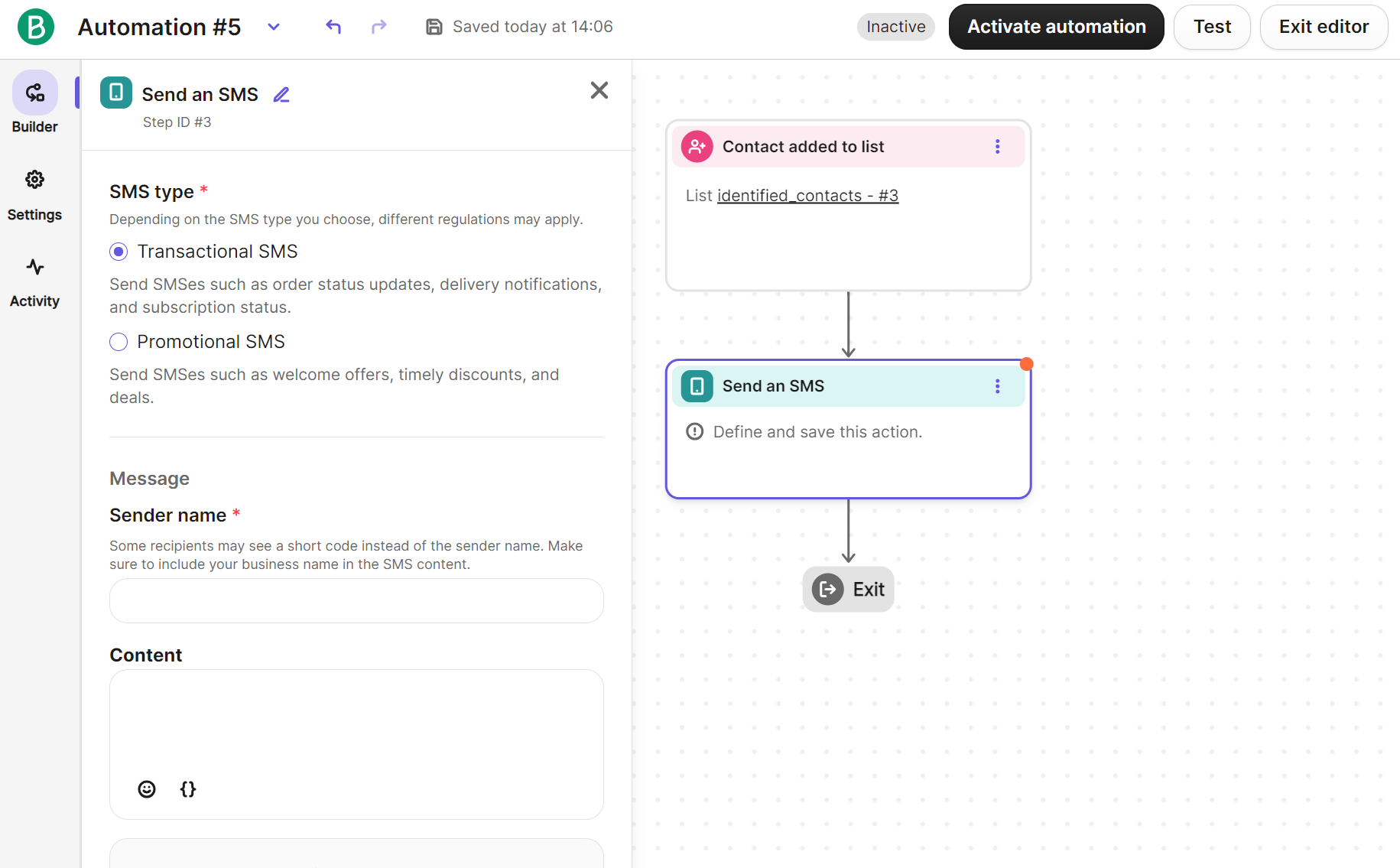
Brevo handles transactional email, SMS, and WhatsApp, letting you combine these channels in transactional flows.
Omnisend’s automation builder is just as intuitive, and it helpfully provides a snapshot of your current SMS credit balance (the image below shows $0.00):
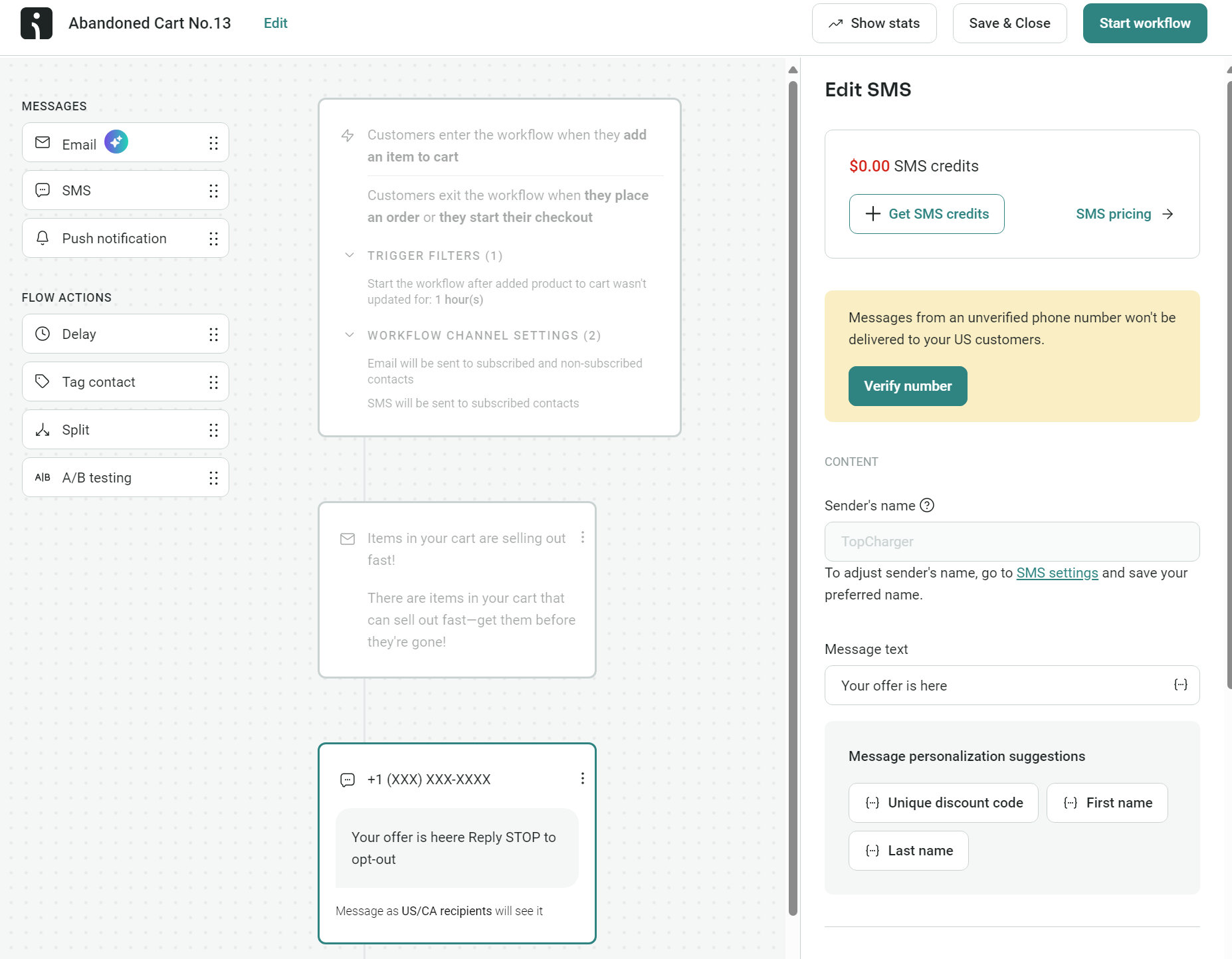
You’ll appreciate Omnisend’s layout if you want to create multichannel sequences. For example, you can create abandoned cart sequences where an email is sent first, an SMS follows if unopened after two hours, and then push notifications serve as final attempts.
Omnisend consolidates reporting across channels for more insights into SMS channel performance. You can view the number of SMS sent, revenue, click rate (if you use trackable links), campaign costs, and unsubscribe rates.
Brevo provides SMS analytics, including delivery rates, click tracking, and geographic distribution, separately from email reports. It’s more challenging to find the information you need from Brevo’s reports than from Omnisend’s.
Integration capabilities
Omnisend has 160+ native app integrations, while Brevo has 150+. Both connect to Zapier, offering additional connections to thousands of apps.
One of Omnisend’s biggest pluses is that it integrates with additional email capture and marketing apps, such as Recart, OptiMonk, WisePops, and OptinMonster.
Additionally, it has one-click ecommerce integrations for Shopify, WooCommerce, BigCommerce, and more. These let you connect your store, import contacts and orders, and start creating email campaigns and automations within 10 minutes.
Some of Omnisend’s newest apps include Starshipit for labeling and tracking, BON loyalty, and Yotpo to bring product reviews to your emails and segments.
Brevo provides similar ecommerce integrations, but its selling point is superior integrations with CRMs, including Salesforce, HubSpot, Zoho, Pipedrive Contacts, Everwin, Streak, Microsoft Dynamics, and GRC Contact. Omnisend’s CRM integrations are limited in comparison.
Here’s what Brevo’s integrations page looks like in the backend:
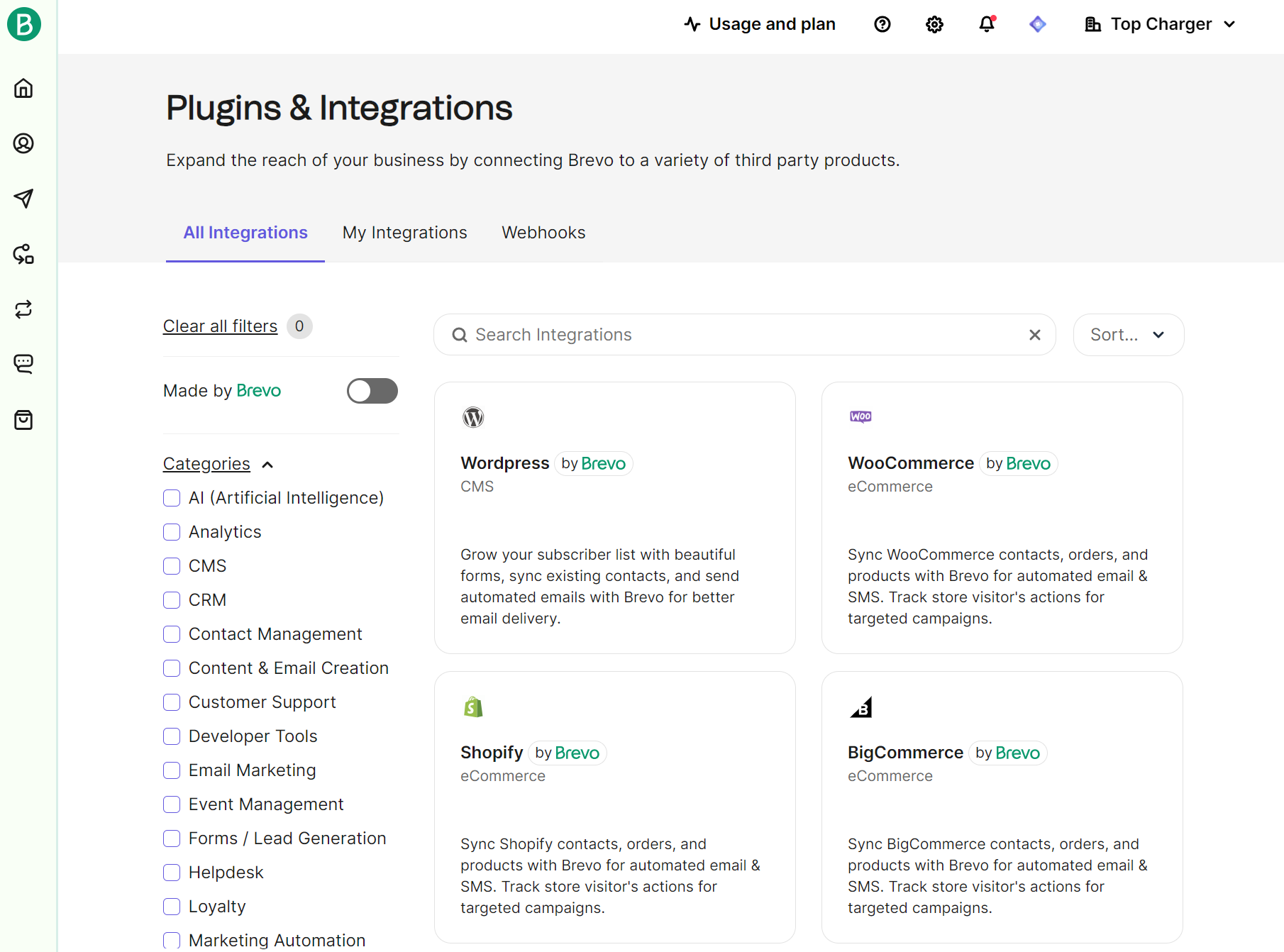
And here’s Omnisend’s App Market page within the backend:
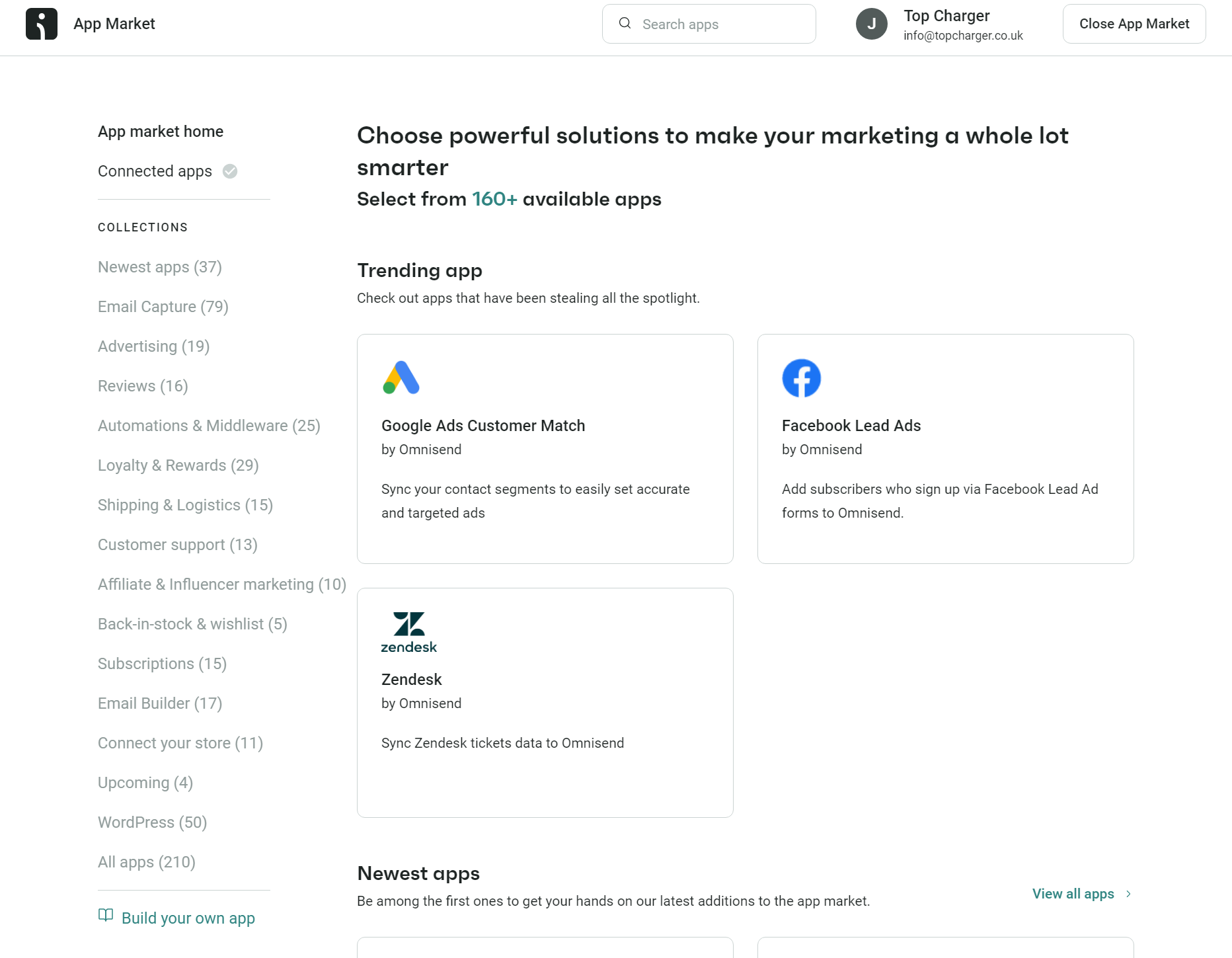
The fact that Omnisend provides an app count for its categories (e.g., 29 for Loyalty & Rewards) is beneficial when assessing scope. Brevo doesn’t give a count, making it difficult to determine whether it’s suitable for your existing stack.
Overall, Brevo has fewer ecommerce integrations for marketing, email builders, loyalty and rewards, and customer support, making Omnisend the better choice for most stores.
Pricing
Brevo is cheaper than Omnisend on paper, but it restricts many ecommerce features behind higher tiers, which could result in having to purchase a more expensive plan to get the features Omnisend provides as standard (such as A/B testing).
Here’s a breakdown of Omnisend vs. Brevo pricing:
Brevo
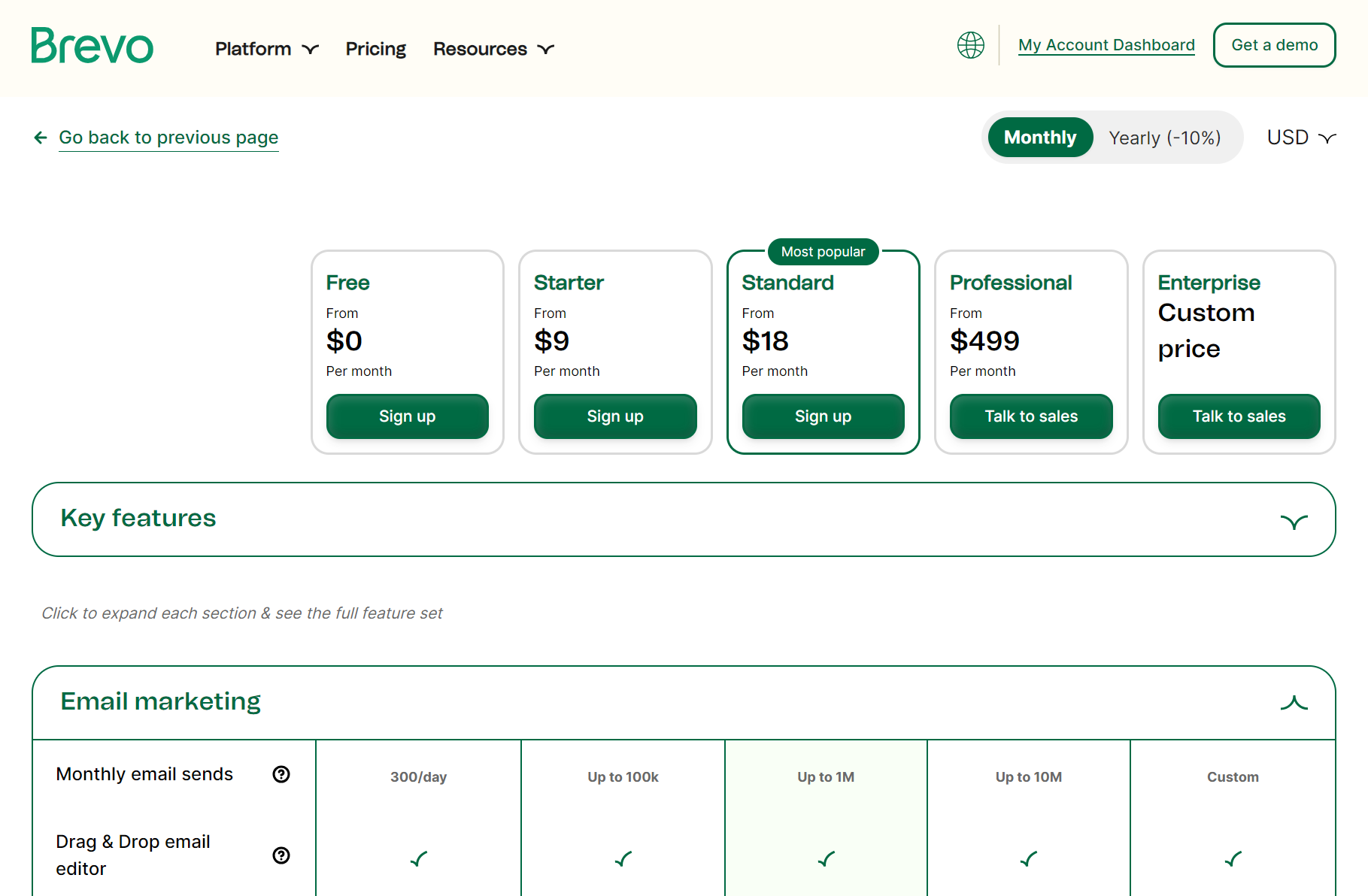
- Free: No cost, 300 daily emails, basic features with a 2,000 contact automation limit
- Starter: $9/month gets you 100k emails, still single-user access
- Standard: $18/month gains you 1M emails, team access for three, full automation
- Professional: $499/month includes 10M emails, analytics studio, 10 users, phone support
- Enterprise: Custom pricing with unlimited capacity, dedicated success manager
Omnisend
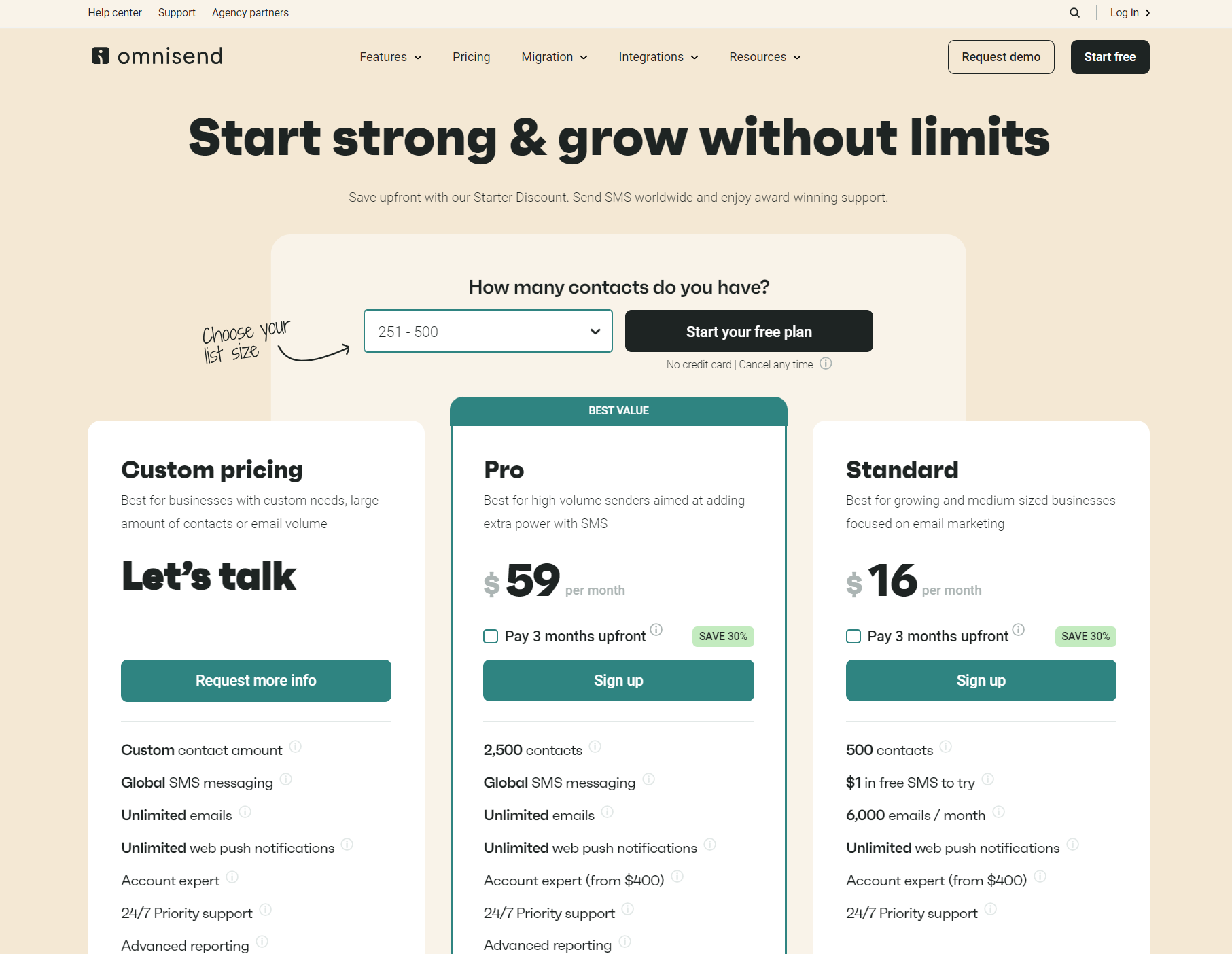
- Free: $0/month, 500 emails/month, 250 contacts, all standard features, $1 SMS credit, unlimited web push notifications
- Standard: From $16/month, 6,000 emails/month, 500 contacts, web push notifications
- Pro: From $59/month, unlimited emails, 2,500 contacts, bonus SMS credits equal to the price of your monthly plan
- Custom: Price on request, free migration, dedicated onboarding
Key pricing differences
Brevo charges based on email volume, Omnisend charges based on contact count. Omnisend includes bonus SMS credits in all plans, while Brevo charges separately for all SMS.
What does this mean in practice? Brevo favors businesses with variable sending patterns, and Omnisend suits those wanting predictable costs tied to list size rather than email volume.
Consider also that while Brevo’s $9/month starting price beats Omnisend’s $16/month, for feature parity, you’re looking at Brevo’s Standard $18/month plan at least.
Use our quick pricing calculator to compare costs for your list size:
Quick email provider pricing comparison
Quickly and easily compare the top email marketing providers so you can find the best platform for your ecommerce store needs.
prices for:
You can compare Omnisend and 2 more providers at once.
- Omnisend
- Klaviyo
- Mailchimp
- Drip
- Moosend
- Active Campaign
- Get Response GetResponse
- MailerLite
You can compare Omnisend and 2 more providers at once.
Select at least one provider.
Try out the full version of this calculator
Customer support
Omnisend offers more support options than Brevo across all plans.
Brevo only offers email support in its Free and Starter plans, bumping that to “priority” email support in its Standard plan. Only professional customers and above get phone support. If you want a customer success manager, you need a custom Enterprise plan.
In comparison, Omnisend provides 24/7 live chat and customer email support across all plans, including free. If you sign up for the Pro plan, you can get an account expert for $400, and the custom plan includes an account expert as standard.
So, how do Brevo vs. Omnisend stack up for real-world customer service?
Omnisend won a Bronze award at the 2025 Stevie® Awards for Sales & Customer Service. Brevo didn’t win a prize in 2025, but it did take Gold for Sales & Customer Service in 2024.
Trustpilot is the best review platform for gauging feedback about customer service, and it doesn’t disappoint for insights into both tools:
Omnisend customer support reviews
- Milena Popovich: “The support team didn’t give up on me. Sanya went above and beyond to help and make sure I was happy. I’m very satisfied and pleasantly surprised by how everything turned out. They truly care about their customers.”
- Ronan O’ Malley: “We are in a middle of moving our store from WC to Shopify, and just wanted to give a shoutout to the Omnisend support team. We had a bunch of questions and concerns before starting, but they walked us through everything and made the re-integration part smooth and less stressful than we expected.”
Brevo customer support reviews
- Tushal webhoppers: “I had a wonderful experience with the Kartikey Sir & Somya Ma’am from Brevo Team. The Brevo Team is polite, patient, and quick to resolve my issue. The support executive Kartikey Sir listened carefully to my concern and provided a clear solution in no time.”
- FW Team: “Deliverability has been excellent so far, and the support team is responsive and helpful — something I stopped expecting from Mailchimp years ago.”
Overall, if 24/7 support via live chat is a crucial feature, Omnisend is the best tool. However, Brevo’s email support is highly rated among customers.
Who should use each platform?
Consider these factors and scenarios when choosing between Brevo vs. Omnisend:
Omnisend is best for
Omnisend is the best-fit email app if you want to improve ecommerce sales and customer experience with omnichannel automations.
Being able to create flows combining email, SMS, and push notifications that trigger based on purchases, engagement, and segment activity ensures your marketing stays synchronized with customers for appropriate targeting.
Complete integration with Shopify, WooCommerce, and BigCommerce is a feature shared with Brevo, but Omnisend’s ecommerce automations mean a better fit for selling online.
24/7 live chat and email support help you maximize these features regardless of plan level. You want an intuitive email app with room to grow, pricing based on contact list size, and a proven ROI (Omnisend’s US customers generate $68 for every $1 spent).
Brevo is best for
Brevo is best for your small to medium-sized business if it manages sales pipelines and sells products online. For instance, you manage service contracts but also sell replacement parts. Brevo gives you a bit of everything, at the expense of advanced ecommerce features.
The built-in CRM connects marketing to sales activities. Track leads, score prospects, manage deals — all while running email campaigns.
WhatsApp business messaging and additional CRM integrations support you better if you have complex customer relationships.
Brevo’s pricing accommodates irregular sending patterns, and the generous free tier (300 emails/day) works for genuine small operations.
Omnisend vs. Brevo (formerly Sendinblue): Final thoughts
The best thing about our Omnisend vs. Brevo comparison is that you can take our information, sign up to both platforms for free, and test them for yourself.
Here’s a summary of what we’ve gathered:
- Email campaigns: Brevo and Omnisend help you build email campaigns, but Omnisend’s email campaign features are created with ecommerce businesses in mind and work out of the box, without additional setup needed
- Marketing automation: You get revenue and engagement data from your workflows when you use Omnisend, and this helps you make the necessary adjustments to increase revenue
- Email list-building: Omnisend offers out-of-the-box list-building tools and capabilities to add more leads to your pipeline, allowing you to launch forms directly from the platform without the need for a code snippet, unlike Brevo
- Segmentation: Omnisend goes beyond basic segmentation features with an AI segment builder and more pre-built segments
- Analytics and reporting: Both Omnisend and Brevo have powerful analytics and reporting capabilities
- Pricing: Brevo is cheaper, but Omnisend offers significantly more features necessary for ecommerce, and you don’t have to pay extra to access them
- Customer support: With Omnisend, you get award-winning customer support that’s available 24/7 and a dedicated Account Expert once you start paying $400/month, regardless of your plan
- SMS campaigns: You’re guaranteed to reach customers from any part of the world with Omnisend
- Integration: Both Omnisend and Brevo offer excellent integration capabilities
You’ll find both platforms to be intuitive and professional, but it’s clear as you start navigating that Omnisend offers more as standard.
Omnisend has more email templates, pre-built segments, automation flows, and it doesn’t lock A/B testing, popups, or landing pages behind paid plans.
If you have an ecommerce store, Omnisend is the obvious choice because all its features are built with your customer journey in mind, from list-building and welcome series experiences to brandable transactional and post-purchase flows.
However, that’s not to say Brevo won’t suit you better. It’s a fantastic tool for small to medium-sized businesses wanting to bring marketing, sales, and deal pipelines together in one platform. Plus, it handles WhatsApp messages.
Try both tools and see which you prefer. Just remember that Omnisend’s free plan provides all standard features and offers better value overall.
Quick sign up | No credit card required
For ecommerce stores prioritizing omnichannel marketing, yes, thanks to its unified workflows across email, SMS, and push notifications. The $68 return per $1 spent among US merchants is proof that it’s worth your time.
The Cake Store, INGLOT Canada, Organic Aromas, 123Presets, Snatcher, Belle Fever, and Reptil are a small portion of Omnisend’s customer base.
Sendinblue is now Brevo. It has a free plan, then it’s $9/month (Starter), $18/month (Standard), and $499/month (Professional). Enterprise requires custom quotes, and SMS costs extra. Also, if you want sales and pipelines, you need an additional sales package, starting from $31/month.
Yes, Brevo’s free plan continues indefinitely with 300 emails daily. It limits automation to 2,000 contacts and doesn’t include A/B testing, landing pages, popups, AI segmentation, contact scoring, and many more features helpful for ecommerce.
For businesses needing email plus CRM functionality, yes. The free tier genuinely supports small operations. Paid plans become expensive quickly, making them less suitable for high-volume senders.
This article was researched and written by our experts following a precise process.
See the processTABLE OF CONTENTS
TABLE OF CONTENTS


No fluff, no spam, no corporate filler. Just a friendly letter, twice a month.

 OFFER
OFFER







